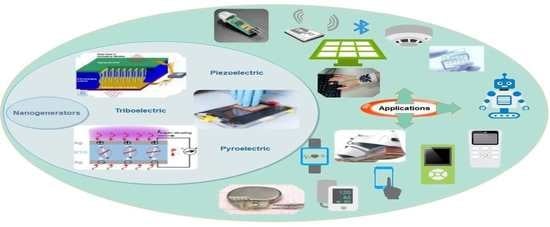Nanogenerators as a Sustainable Power Source: State of Art, Applications, and Challenges
Abstract
1. Introduction
2. History and Development of Nanogenerators
3. Nanogenerators Based on Piezoelectric Effect
3.1. Progress and Output Power Optimization in PENGs
3.2. Applications of PENGs
3.3. Outlook on PENGs
4. Nanogenerators Based on the Triboelectric Effect
4.1. Progress and Output Power Optimization in TENGs
4.2. Review of Applications of TENG
4.2.1. Self-Powered Sensors
4.2.2. Harvesting Blue Energy
4.2.3. Harvesting Wind Energy
4.2.4. Solar Photovoltaic Technology
4.3. Outlook on TENGs
5. Nanogenerators Based on Thermoelectric Effect (Seebeck Effect)
6. Nanogenerators Based on Pyroelectric Effect
Review on Progress and Output Power Optimization in PyENG
7. Conclusions
Author Contributions
Funding
Acknowledgments
Conflicts of Interest
References
- BP Energy Economics. BP Energy Outlook, 2018 ed.; BP p.l.c.: London, UK, 2018. [Google Scholar]
- Hu, Y.; Wang, Z.L. Recent progress in piezoelectric nanogenerators as a sustainable power source in self-powered systems and active sensors. Nano Energy 2014, 14, 3–14. [Google Scholar] [CrossRef]
- Beeby, S.P.; Tudor, M.J.; White, N.M. Energy harvesting vibration sources for microsystems applications. Meas. Sci. Technol 2006, 17, 175–195. [Google Scholar] [CrossRef]
- Batra, A.K.; Alomari, A. Ambient Energy Sources: Mechanical, Light, and Thermal. In Power Harvesting via Smart Materials; SPIE Press: Bellingham, WA, USA, 2017; pp. 1–15. ISBN 9781510608498. [Google Scholar]
- Wang, Z.L. Self-Powered Nanotech. Sci. Am. 2008, 298, 82–87. [Google Scholar] [CrossRef] [PubMed]
- Schiffer, M.B. Draw the Lightning Down: Benjamin Franklin and Electrical Technology in the Age of Enlightenment; University of California Press: Berkeley, CA, USA, 2006; Volume 408. [Google Scholar]
- Kagan, C.R.; Fernandez, L.E.; Gogotsi, Y.; Hammond, P.T.; Hersam, M.C.; Nel, A.E.; Penner, R.M.; Willson, C.G.; Weiss, P.S. Nano Day: Celebrating the Next Decade of Nanoscience and Nanotechnology. ACS Nano 2016, 10, 9093–9103. [Google Scholar] [CrossRef]
- Wang, Z.L. Piezoelectric Nanogenerators Based on Zinc Oxide Nanowire Arrays. Science 2006, 312, 242–246. [Google Scholar] [CrossRef] [PubMed]
- Kumar, B.; Kim, S.W. Energy harvesting based on semiconducting piezoelectric ZnO nanostructures. Nano Energy 2012, 1, 342–355. [Google Scholar] [CrossRef]
- Askari, H.; Khajepour, A.; Khamesee, M.B.; Saadatnia, Z.; Wang, Z.L. Piezoelectric and triboelectric nanogenerators: Trends and impacts. Nano Today 2018, 22, 10–13. [Google Scholar] [CrossRef]
- Zi, Y.; Wang, Z.L. Nanogenerators: An emerging technology towards nanoenergy. APL Mater. 2017, 5, 074103. [Google Scholar] [CrossRef]
- Noliac Piezo basics. Text. Res. J. 2012, 3, 1–19.
- Nechibvute, A.; Chawanda, A.; Luhanga, P. Piezoelectric Energy Harvesting Devices: An Alternative Energy Source for Wireless Sensors. Smart Mater. Res. 2012, 2012, 853481. [Google Scholar] [CrossRef]
- Wang, X. Piezoelectric nanogenerators—Harvesting ambient mechanical energy at the nanometer scale. Nano Energy 2012, 1, 13–24. [Google Scholar] [CrossRef]
- Gao, Y.; Wang, Z.L. Electrostatic potential in a bent piezoelectric nanowire. The fundamental theory of nanogenerator and nanopiezotronics. Nano Lett. 2007, 7, 2499–2505. [Google Scholar] [CrossRef]
- Roji, A.M.M.; Jiji, G.; Raj, A.B.T. A retrospect on the role of piezoelectric nanogenerators in the development of the green world. RSC Adv. 2017, 7, 33642–33670. [Google Scholar] [CrossRef]
- Zhang, C.; Yan, Y.; Sheng Zhao, Y.; Yao, J. Synthesis and applications of organic nanorods, nanowires and nanotubes. Annu. Rep. Prog. Chem. Sect. C 2013, 109, 211–239. [Google Scholar] [CrossRef]
- Zhu, G.; Wang, A.C.; Liu, Y.; Zhou, Y.; Wang, Z.L. Functional Electrical Stimulation by Nanogenerator with 58 V Output Voltage. Nano Lett. 2012, 12, 3086–3090. [Google Scholar] [CrossRef] [PubMed]
- Wang, Z.L.; Zhu, G.; Yang, Y.; Wang, S.; Pan, C. Progress in nanogenerators for portable electronics. Mater. Today 2012, 15, 532–543. [Google Scholar] [CrossRef]
- Wang, Z.; Pan, X.; He, Y.; Hu, Y.; Gu, H.; Wang, Y. Piezoelectric Nanowires in Energy Harvesting Applications. Adv. Mater. Sci. Eng. 2015, 2015, 165631. [Google Scholar] [CrossRef]
- Park, W.I.; Yi, G.C.; Kim, J.W.; Park, S.M. Schottky nanocontacts on ZnO nanorod arrays. Appl. Phys. Lett. 2003, 82, 4358–4360. [Google Scholar] [CrossRef]
- Briscoe, J.; Dunn, S. Piezoelectric nanogenerators—A review of nanostructured piezoelectric energy harvesters. Nano Energy 2014, 14, 15–29. [Google Scholar] [CrossRef]
- Wang, X.; Song, J.; Liu, J.; Wang, Z.L. Direct-Current Nanogenerator Driven by Ultrasonic Waves. J. Jpn. For. Soc. 2007, 316, 102–105. [Google Scholar] [CrossRef]
- Qin, Y.; Wang, X.; Wang, Z.L. Microfibre–nanowire hybrid structure for energy scavenging. Nature 2008, 451, 809–813. [Google Scholar] [CrossRef]
- Lin, Y.F.; Song, J.; Ding, Y.; Lu, S.Y.; Wang, Z.L. Piezoelectric nanogenerator using CdS nanowires. Appl. Phys. Lett. 2008, 92, 23–25. [Google Scholar] [CrossRef]
- Yang, R.; Qin, Y.; Dai, L.; Wang, Z.L. Power generation with laterally packaged piezoelectric fine wires. Nat. Nanotechnol. 2009, 4, 34–39. [Google Scholar] [CrossRef] [PubMed]
- Zhu, G.; Yang, R.; Wang, S.; Wang, Z.L. Flexible high-output nanogenerator based on lateral ZnO nanowire array. Nano Lett. 2010, 10, 3151–3155. [Google Scholar] [CrossRef] [PubMed]
- Lin, Y.F.; Song, J.; Ding, Y.; Lu, S.Y.; Wang, Z.L. Alternating the output of a CdS nanowire nanogenerator by a white-light-stimulated optoelectronic effect. Adv. Mater. 2008, 20, 3127–3130. [Google Scholar] [CrossRef]
- Xu, S.; Qin, Y.; Xu, C.; Wei, Y.; Yang, R.; Wang, Z.L. Self-powered nanowire devices. Nat. Nanotechnol. 2010, 5, 366–373. [Google Scholar] [CrossRef]
- Huang, C.T.; Song, J.; Tsai, C.M.; Lee, W.F.; Lien, D.H.; Gao, Z.; Hao, Y.; Chen, L.J.; Wang, Z.L. Single-InN-nanowire nanogenerator with upto 1 v output voltage. Adv. Mater. 2010, 22, 4008–4013. [Google Scholar] [CrossRef]
- Chen, X.; Xu, S.; Yao, N.; Shi, Y. 1.6 v nanogenerator for mechanical energy harvesting using PZT nanofibers. Nano Lett. 2010, 10, 2133–2137. [Google Scholar] [CrossRef] [PubMed]
- Cha, S.; Kim, S.M.; Kim, H.; Ku, J.; Sohn, J.I.; Park, Y.J.; Song, B.G.; Jung, M.H.; Lee, E.K.; Choi, B.L.; et al. Porous PVDF as effective sonic wave driven nanogenerators. Nano Lett. 2011, 11, 5142–5147. [Google Scholar] [CrossRef]
- Hu, Y.; Liu, Y.; Li, W.; Gao, M.; Liang, X.; Li, Q.; Peng, L.M. Observation of a 2D electron gas and the tuning of the electrical conductance of ZnO nanowires by controllable surface band-bending. Adv. Funct. Mater. 2009, 19, 2380–2387. [Google Scholar] [CrossRef]
- Lu, S.; Qi, J.; Gu, Y.; Liu, S.; Xu, Q.; Wang, Z.; Liang, Q.; Zhang, Y. Influence of the carrier concentration on the piezotronic effect in a ZnO/Au Schottky junction. Nanoscale 2015, 7, 4461–4467. [Google Scholar] [CrossRef]
- Hu, Y.; Lin, L.; Zhang, Y.; Wang, Z.L. Replacing a battery by a nanogenerator with 20 v output. Adv. Mater. 2012, 24, 110–114. [Google Scholar] [CrossRef] [PubMed]
- Sohn, J.I.; Cha, S.N.; Song, B.G.; Lee, S.; Kim, S.M.; Ku, J.; Kim, H.J.; Park, Y.J.; Choi, B.L.; Wang, Z.L.; et al. Engineering of efficiency limiting free carriers and an interfacial energy barrier for an enhancing piezoelectric generation. Energy Environ. Sci. 2013, 6, 97–104. [Google Scholar] [CrossRef]
- Ram, C.; Sivamani, S.; Micha Premkumar, T.; Hariram, V. Computational study of leading edge jet impingement cooling with a conical converging hole for blade cooling. ARPN J. Eng. Appl. Sci. 2017, 12, 6397–6406. [Google Scholar]
- Shin, S.H.; Kim, Y.H.; Lee, M.H.; Jung, J.Y.; Seol, J.H.; Nah, J. Lithium-doped zinc oxide nanowires-polymer composite for high performance flexible piezoelectric nanogenerator. ACS Nano 2014, 8, 10844–10850. [Google Scholar] [CrossRef]
- Pham, T.T.; Lee, K.Y.; Lee, J.-H.; Kim, K.-H.; Shin, K.-S.; Gupta, M.K.; Kumar, B.; Kim, S.-W. Reliable operation of a nanogenerator under ultraviolet light via engineering piezoelectric potential. Energy Environ. Sci. 2013, 6, 841–846. [Google Scholar] [CrossRef]
- Zhou, Y.S.; Wang, K.; Han, W.; Rai, S.C.; Zhang, Y.; Ding, Y.; Pan, C.; Zhang, F.; Zhou, W.; Wang, Z.L. Vertically aligned cdse nanowire arrays for energy harvesting and piezotronic devices. ACS Nano 2012, 6, 6478–6482. [Google Scholar] [CrossRef]
- Han, M.; Zhang, X.S.; Meng, B.; Liu, W.; Tang, W.; Sun, X.; Wang, W.; Zhang, H. R-shaped hybrid nanogenerator with enhanced piezoelectricity. ACS Nano 2013, 7, 8554–8560. [Google Scholar] [CrossRef]
- Cho, K.S.; Kim, D.H.; Kim, Y.H.; Nah, J.; Kim, H.K. Li-doped Cu2O/ZnO heterojunction for flexible and semi-transparent piezoelectric nanogenerators. Ceram. Int. 2017, 43, 2279–2287. [Google Scholar] [CrossRef]
- Lu, S.; Liao, Q.; Qi, J.; Liu, S.; Liu, Y.; Liang, Q.; Zhang, G.; Zhang, Y. The enhanced performance of piezoelectric nanogenerator via suppressing screening effect with Au particles/ZnO nanoarrays Schottky junction. Nano Res. 2016, 9, 372–379. [Google Scholar] [CrossRef]
- Ghosh, S.K.; Mandal, D. High-performance bio-piezoelectric nanogenerator made with fish scale. Appl. Phys. Lett. 2016, 109, 103701. [Google Scholar] [CrossRef]
- Xu, H.B.; Lee, T.G.; Park, S.J.; Kim, B.Y.; Nahm, S. Sodium-potassium niobate nanorods with various crystal structures and their application to nanogenerator. J. Am. Ceram. Soc. 2017, 100, 1673–1681. [Google Scholar] [CrossRef]
- Chen, X.; Li, X.; Shao, J.; An, N.; Tian, H.; Wang, C.; Han, T.; Wang, L.; Lu, B. High-Performance Piezoelectric Nanogenerators with Imprinted P(VDF-TrFE)/BaTiO3Nanocomposite Micropillars for Self-Powered Flexible Sensors. Small 2017, 13, 1604245. [Google Scholar] [CrossRef]
- Dudem, B.; Kim, D.H.; Bharat, L.K.; Yu, J.S. Highly-flexible piezoelectric nanogenerators with silver nanowires and barium titanate embedded composite films for mechanical energy harvesting. Appl. Energy 2018, 230, 865–874. [Google Scholar] [CrossRef]
- Shi, K.; Sun, B.; Huang, X.; Jiang, P. Synergistic effect of graphene nanosheet and BaTiO3nanoparticles on performance enhancement of electrospun PVDF nanofiber mat for flexible piezoelectric nanogenerators. Nano Energy 2018, 52, 153–162. [Google Scholar] [CrossRef]
- Jenkins, K.; Kelly, S.; Nguyen, V.; Wu, Y.; Yang, R. Piezoelectric diphenylalanine peptide for greatly improved flexible nanogenerators. Nano Energy 2018, 51, 317–323. [Google Scholar] [CrossRef]
- Yan, J.; Liu, M.; Jeong, Y.G.; Kang, W.; Li, L.; Zhao, Y.; Deng, N.; Cheng, B.; Yang, G. Performance Enhancements in Poly(vinylidene fluoride)-based Piezoelectric Nanogenerators for Efficient Energy Harvesting. Nano Energy 2018, 56, 662–692. [Google Scholar] [CrossRef]
- Filippin, A.N.; Sanchez-Valencia, J.R.; Garcia-Casas, X.; Lopez-Flores, V.; Macias-Montero, M.; Frutos, F.; Barranco, A.; Borras, A. 3D core-multishell piezoelectric nanogenerators. Nano Energy 2019, 58, 476–483. [Google Scholar] [CrossRef]
- Kang, J.H.; Jeong, D.K.; Ha, J.S.; Lee, J.K.; Ryu, S.W. Enhanced performance of a GaN piezoelectric nanogenerator with an embedded nanoporous layer via the suppressed carrier screening effect. Semicond. Sci. Technol. 2017, 32, 025001. [Google Scholar] [CrossRef]
- Kang, J.H.; Jeong, D.K.; Ryu, S.W. Transparent, Flexible Piezoelectric Nanogenerator Based on GaN Membrane Using Electrochemical Lift-Off. ACS Appl. Mater. Interfaces 2017, 9, 10637–10642. [Google Scholar] [CrossRef] [PubMed]
- Johar, M.A.; Kang, J.H.; Hassan, M.A.; Ryu, S.W. A scalable, flexible and transparent GaN based heterojunction piezoelectric nanogenerator for bending, air-flow and vibration energy harvesting. Appl. Energy 2018, 222, 781–789. [Google Scholar] [CrossRef]
- Johar, M.; Hassan, M.; Waseem, A.; Ha, J.-S.; Lee, J.; Ryu, S.-W. Stable and High Piezoelectric Output of GaN Nanowire-Based Lead-Free Piezoelectric Nanogenerator by Suppression of Internal Screening. Nanomaterials 2018, 8, 437. [Google Scholar] [CrossRef]
- Ku, N.J.; Liu, G.; Wang, C.H.; Gupta, K.; Liao, W.S.; Ban, D.; Liu, C.P. Optimal geometrical design of inertial vibration DC piezoelectric nanogenerators based on obliquely aligned InN nanowire arrays. Nanoscale 2017, 9, 14039–14046. [Google Scholar] [CrossRef]
- Lee, E.J.; Kim, T.Y.; Kim, S.W.; Jeong, S.; Choi, Y.; Lee, S.Y. High-performance piezoelectric nanogenerators based on chemically-reinforced composites. Energy Environ. Sci. 2018, 11, 1425–1430. [Google Scholar] [CrossRef]
- Maria Joseph Raj, N.P.; Alluri, N.R.; Khandelwal, G.; Kim, S.J. Lead-free piezoelectric nanogenerator using lightweight composite films for harnessing biomechanical energy. Compos. Part B Eng. 2019, 161, 608–616. [Google Scholar] [CrossRef]
- Bera, B. Recent Advances in Piezoelectric Nano generators in Energy Harvesting Applications. Imp. J. Interdiscip. Res. 2016, 2, 1274–1291. [Google Scholar]
- Jella, V.; Ippili, S.; Eom, J.-H.; Pammi, S.V.N.; Jung, J.-S.; Tran, V.-D.; Nguyen, V.H.; Kirakosyan, A.; Yun, S.; Kim, D.; et al. A Comprehensive Review of Flexible Piezoelectric Generators Based on Organic-Inorganic Metal Halide Perovskites. Nano Energy 2019, 57, 74–93. [Google Scholar] [CrossRef]
- Hu, Y.; Xu, C.; Zhang, Y.; Lin, L.; Snyder, R.L.; Wang, Z.L. A nanogenerator for energy harvesting from a rotating tire and its application as a self-powered pressure/speed sensor. Adv. Mater. 2011, 23, 4068–4071. [Google Scholar] [CrossRef]
- Zhao, Y.; Deng, P.; Nie, Y.; Wang, P.; Zhang, Y.; Xing, L.; Xue, X. Biomolecule-adsorption-dependent piezoelectric output of ZnO nanowire nanogenerator and its application as self-powered active biosensor. Biosens. Bioelectron. 2014, 57, 269–275. [Google Scholar] [CrossRef]
- Li, Z.; Yang, R.; Yu, M.; Bai, F.; Li, C.; Wang, Z.L. Cellular level biocompatibility and biosafety of ZnO nanowires. J. Phys. Chem. C 2008, 112, 20114–20117. [Google Scholar] [CrossRef]
- Hwang, G.T.; Park, H.; Lee, J.H.; Oh, S.; Park, K.I.; Byun, M.; Park, H.; Ahn, G.; Jeong, C.K.; No, K.; et al. Self-powered cardiac pacemaker enabled by flexible single crystalline PMN-PT piezoelectric energy harvester. Adv. Mater. 2014, 26, 4880–4887. [Google Scholar] [CrossRef]
- Lenaers, A.; van Thiel, E.; Block, P.; Verelst, J.; Jeghers, O.; Froideville, J.L. Effect of image computer processing on the sensitivity and specificity of stress myocardial scintigraphy. Acta Cardiol. Suppl. 1981, 26, 95–103. [Google Scholar]
- Park, K.I.; Son, J.H.; Hwang, G.T.; Jeong, C.K.; Ryu, J.; Koo, M.; Choi, I.; Lee, S.H.; Byun, M.; Wang, Z.L.; et al. Highly-efficient, flexible piezoelectric PZT thin film nanogenerator on plastic substrates. Adv. Mater. 2014, 26, 2514–2520. [Google Scholar] [CrossRef]
- Wang, Z.L. Towards self-powered nanosystems: From nanogenerators to nanopiezotronics. Adv. Funct. Mater. 2008, 18, 3553–3567. [Google Scholar] [CrossRef]
- Yang, R.; Qin, Y.; Li, C.; Zhu, G.; Wang, Z.L. Converting Biomechanical Energy into Electricity by a Muscle-Movement-Driven Nanogenerator. Nano Lett. 2009, 9, 1201–1205. [Google Scholar] [CrossRef]
- Li, X.; Lin, Z.; Cheng, G.; Wen, X.; Liu, Y.; Niu, S. 3D Fiber-Based Hybrid Nanogenerator for Energy Harvesting and as a. ACS Nano 2014, 8, 10674–10681. [Google Scholar] [CrossRef]
- Zhang, L.; Bai, S.; Su, C.; Zheng, Y.; Qin, Y.; Xu, C.; Wang, Z.L. A High-Reliability Kevlar Fiber-ZnO Nanowires Hybrid Nanogenerator and its Application on Self-Powered UV Detection. Adv. Funct. Mater. 2015, 25, 5794–5798. [Google Scholar] [CrossRef]
- Fan, F.R.; Tang, W.; Wang, Z.L. Flexible Nanogenerators for Energy Harvesting and Self-Powered Electronics. Adv. Mater. 2016, 28, 4283–4305. [Google Scholar] [CrossRef]
- Alluri, N.R.; Saravanakumar, B.; Kim, S.J. Flexible, hybrid piezoelectric film (BaTi(1−x)/Zrx/O3)/PVDF nanogenerator as a self-powered fluid velocity sensor. ACS Appl. Mater. Interfaces 2015, 7, 9831–9840. [Google Scholar] [CrossRef]
- Alam, M.M.; Ghosh, S.K.; Sultana, A.; Mandal, D. Lead-free ZnSnO3/MWCNTs-based self-poled flexible hybrid nanogenerator for piezoelectric power generation. Nanotechnology 2015, 26, 165403. [Google Scholar] [CrossRef]
- Lee, J.H.; Lee, K.Y.; Gupta, M.K.; Kim, T.Y.; Lee, D.Y.; Oh, J.; Ryu, C.; Yoo, W.J.; Kang, C.Y.; Yoon, S.J.; et al. Highly stretchable piezoelectric-pyroelectric hybrid nanogenerator. Adv. Mater. 2014, 26, 765–769. [Google Scholar] [CrossRef]
- Lee, D.-Y.; Kim, H.; Li, H.-M.; Jang, A.-R.; Lim, Y.-D.; Cha, S.N.; Park, Y.J.; Kang, D.J.; Yoo, W.J. Hybrid energy harvester based on nanopillar solar cells and PVDF nanogenerator. Nanotechnology 2013, 24, 175402. [Google Scholar] [CrossRef]
- Zhu, L.; Wang, L.; Pan, C.; Chen, L.; Xue, F.; Chen, B.; Yang, L.; Su, L.; Wang, Z.L. Enhancing the Efficiency of Silicon-Based Solar Cells by the Piezo-Phototronic Effect. ACS Nano 2017, 11, 1894–1900. [Google Scholar] [CrossRef]
- Maity, K.; Mandal, D. All-Organic High-Performance Piezoelectric Nanogenerator with Multilayer Assembled Electrospun Nanofiber Mats for Self-Powered Multifunctional Sensors. ACS Appl. Mater. Interfaces 2018, 10, 18257–18269. [Google Scholar] [CrossRef]
- Sultana, A.; Alam, M.M.; Ghosh, S.K.; Middya, T.R.; Mandal, D. Energy harvesting and self-powered microphone application on multifunctional inorganic-organic hybrid nanogenerator. Energy 2018, 166, 963–971. [Google Scholar] [CrossRef]
- Lin, L.; Hu, Y.; Xu, C.; Zhang, Y.; Zhang, R.; Wen, X.; Lin Wang, Z. Transparent flexible nanogenerator as self-powered sensor for transportation monitoring. Nano Energy 2013, 2, 75–81. [Google Scholar] [CrossRef]
- Yang, Y.; Wang, S.; Zhang, Y.; Wang, Z.L. Supplementary materials Pyroelectric Nanogenerators for Driving Wireless Sensors. Nano Lett. Support. Inf. 2012, 12, 6408–6413. [Google Scholar] [CrossRef]
- Ali, F.; Raza, W.; Li, X.; Gul, H.; Kim, K.-H. Piezoelectric Energy Harvesters for Biomedical Applications. Nano Energy 2019, 57, 879–902. [Google Scholar] [CrossRef]
- Li, X.; Sun, M.; Wei, X.; Shan, C.; Chen, Q. 1D Piezoelectric Material Based Nanogenerators: Methods, Materials and Property Optimization. Nanomaterials 2018, 8, 188. [Google Scholar] [CrossRef]
- Zhou, Y.; Liu, W.; Huang, X.; Zhang, A.; Zhang, Y.; Wang, Z.L. Theoretical study on two-dimensional MoS2 piezoelectric nanogenerators. Nano Res. 2016, 9, 800–807. [Google Scholar] [CrossRef]
- Weiss, P.S. A conversation with Prof. Zhong Lin Wang, energy harvester. ACS Nano 2015, 9, 2221–2226. [Google Scholar] [CrossRef]
- Zi, Y.; Niu, S.; Wang, J.; Wen, Z.; Tang, W.; Wang, Z.L. Standards and figure-of-merits for quantifying the performance of triboelectric nanogenerators. Nat. Commun. 2015, 6, 8376. [Google Scholar] [CrossRef]
- Wang, Z.L.; Chen, J.; Lin, L. Progress in triboelectric nanogenerators as a new energy technology and self-powered sensors. Energy Environ. Sci. 2015, 8, 2250–2282. [Google Scholar] [CrossRef]
- Wang, Z.L. Triboelectric nanogenerators as new energy technology and self-powered sensors—Principles, problems and perspectives. Faraday Discuss. 2014, 176, 447–458. [Google Scholar] [CrossRef]
- Fan, F.R.; Tian, Z.Q.; Lin Wang, Z. Flexible triboelectric generator. Nano Energy 2012, 1, 328–334. [Google Scholar] [CrossRef]
- Wang, Z.L. Triboelectric Nanogenerators as New Energy Technology for Self-Powered Systems and as Active Mechanical and Chemical Sensors. ACS Nano 2013, 7, 9533–9557. [Google Scholar] [CrossRef]
- Niu, S.; Wang, Z.L. Theoretical systems of triboelectric nanogenerators. Nano Energy 2014, 14, 161–192. [Google Scholar] [CrossRef]
- Davies, D.K. Charge generation on dielectric surfaces. J. Phys. D Appl. Phys. 1969, 2, 1533–1537. [Google Scholar] [CrossRef]
- Zi, Y.; Lin, L.; Wang, J.; Wang, S.; Chen, J.; Fan, X.; Yang, P.K.; Yi, F.; Wang, Z.L. Triboelectric-pyroelectric-piezoelectric hybrid cell for high-efficiency energy-harvesting and self-powered sensing. Adv. Mater. 2015, 27, 2340–2347. [Google Scholar] [CrossRef]
- Lin, Z.; Chen, J.; Yang, J. Recent Progress in Triboelectric Nanogenerators as a Renewable and Sustainable Power Source. J. Nanomater. 2016, 2016, 5651613. [Google Scholar] [CrossRef]
- Rathore, S.; Sharma, S.; Swain, B.P.; Ghadai, R.K. A Critical Review on Triboelectric Nanogenerator. IOP Conf. Ser. Mater. Sci. Eng. 2018, 377, 012186. [Google Scholar] [CrossRef]
- Wang, Z.L.; Lin, L.; Chen, J.; Niu, S.; Zi, Y. Triboelectric Nanogenerators; Springer: Berlin, Germany, 2016; ISBN 978-3-319-40038-9. [Google Scholar]
- Feng, Y.; Zhang, L.; Zheng, Y.; Wang, D.; Zhou, F.; Liu, W. Leaves based triboelectric nanogenerator (TENG) and TENG tree for wind energy harvesting. Nano Energy 2019, 55, 260–268. [Google Scholar] [CrossRef]
- Mallineni, S.S.K.; Dong, Y.; Behlow, H.; Rao, A.M.; Podila, R. A Wireless Triboelectric Nanogenerator. Adv. Energy Mater. 2018, 8, 1702736. [Google Scholar] [CrossRef]
- Zhu, G.; Pan, C.; Guo, W.; Chen, C.Y.; Zhou, Y.; Yu, R.; Wang, Z.L. Triboelectric-generator-driven pulse electrodeposition for micropatterning. Nano Lett. 2012, 12, 4960–4965. [Google Scholar] [CrossRef]
- Zhu, G.; Lin, Z.H.; Jing, Q.; Bai, P.; Pan, C.; Yang, Y.; Zhou, Y.; Wang, Z.L. Toward large-scale energy harvesting by a nanoparticle-enhanced triboelectric nanogenerator. Nano Lett. 2013, 13, 847–853. [Google Scholar] [CrossRef]
- Yun, B.K.; Kim, J.W.; Kim, H.S.; Jung, K.W.; Yi, Y.; Jeong, M.S.; Ko, J.H.; Jung, J.H. Base-treated polydimethylsiloxane surfaces as enhanced triboelectric nanogenerators. Nano Energy 2015, 15, 523–529. [Google Scholar] [CrossRef]
- Hu, Y.; Yang, J.; Jing, Q.; Niu, S.; Wu, W.; Wang, Z.L. Triboelectric nanogenerator built on suspended 3d spiral structure as vibration and positioning sensor and wave energy harvester. ACS Nano 2013, 7, 10424–10432. [Google Scholar] [CrossRef]
- Chen, J.; Zhu, G.; Yang, W.; Jing, Q.; Bai, P.; Yang, Y.; Hou, T.C.; Wang, Z.L. Harmonic-resonator-based triboelectric nanogenerator as a sustainable power source and a self-powered active vibration sensor. Adv. Mater. 2013, 25, 6094–6099. [Google Scholar] [CrossRef]
- Cheng, G.; Lin, Z.H.; Lin, L.; Du, Z.L.; Wang, Z.L. Pulsed nanogenerator with huge instantaneous output power density. ACS Nano 2013, 7, 7383–7391. [Google Scholar] [CrossRef]
- Yang, W.; Chen, J.; Jing, Q.; Yang, J.; Wen, X.; Su, Y.; Zhu, G.; Bai, P.; Wang, Z.L. 3D stack integrated triboelectric nanogenerator for harvesting vibration energy. Adv. Funct. Mater. 2014, 24, 4090–4096. [Google Scholar] [CrossRef]
- Lin, Z.H.; Cheng, G.; Lee, S.; Pradel, K.C.; Wang, Z.L. Harvesting water drop energy by a sequential contact-electrification and electrostatic-induction process. Adv. Mater. 2014, 26, 4690–4696. [Google Scholar] [CrossRef]
- Evans, D. The Internet of Things: How the Next Evolution of the Internet Is Changing Everything; CISCO: San Jose, CA, USA, 2011. [Google Scholar]
- Chen, B.; Tang, W.; Jiang, T.; Zhu, L.; Chen, X.; He, C.; Xu, L.; Guo, H.; Lin, P.; Li, D.; et al. Three-dimensional ultraflexible triboelectric nanogenerator made by 3D printing. Nano Energy 2018, 45, 380–389. [Google Scholar] [CrossRef]
- Xie, Y.; Wang, S.; Niu, S.; Lin, L.; Jing, Q.; Yang, J.; Wu, Z.; Wang, Z.L. Grating-Structured Freestanding Triboelectric-Layer Nanogenerator for Harvesting Mechanical Energy at 85% Total Conversion Efficiency. Adv. Mater. 2014, 26, 6599–6607. [Google Scholar] [CrossRef]
- Nanogenerator, T.; Cheng, G.; Lin, Z.; Du, Z.; Wang, Z.L. Simultaneously Harvesting Electrostatic and Mechanical Energies from Flowing Water by a Hybridized. ACS Nano 2014, 8, 1932–1939. [Google Scholar]
- Shi, L.; Dong, S.; Ding, P.; Chen, J.; Liu, S.; Huang, S.; Xu, H.; Farooq, U.; Zhang, S.; Li, S.; et al. Carbon Electrodes Enable Flat Surface PDMS and PA6 Triboelectric Nanogenerators to Achieve Significantly Enhanced Triboelectric Performance. Nano Energy 2019, 55, 548–557. [Google Scholar] [CrossRef]
- Liu, L.; Tang, W.; Deng, C.; Chen, B.; Han, K.; Zhong, W.; Wang, Z.L. Self-powered versatile shoes based on hybrid nanogenerators. Nano Res. 2018, 11, 3972–3978. [Google Scholar] [CrossRef]
- Yang, W.; Chen, J.; Zhu, G.; Yang, J.; Bai, P.; Su, Y.; Jing, Q.; Cao, X.; Wang, Z.L. Harvesting energy from the natural vibration of human walking. ACS Nano 2013, 7, 11317–11324. [Google Scholar] [CrossRef]
- Guo, Y.; Zhang, X.S.; Wang, Y.; Gong, W.; Zhang, Q.; Wang, H.; Brugger, J. All-fiber hybrid piezoelectric-enhanced triboelectric nanogenerator for wearable gesture monitoring. Nano Energy 2018, 48, 152–160. [Google Scholar] [CrossRef]
- Zhai, C.; Chou, X.; He, J.; Song, L.; Zhang, Z.; Wen, T.; Tian, Z.; Chen, X.; Zhang, W.; Niu, Z.; et al. An electrostatic discharge based needle-to-needle booster for dramatic performance enhancement of triboelectric nanogenerators. Appl. Energy 2018, 231, 1346–1353. [Google Scholar] [CrossRef]
- Zhu, G.; Zhou, Y.S.; Bai, P.; Meng, X.S.; Jing, Q.; Chen, J.; Wang, Z.L. A shape-adaptive thin-film-based approach for 50% high-efficiency energy generation through micro-grating sliding electrification. Adv. Mater. 2014, 26, 3788–3796. [Google Scholar] [CrossRef]
- Kim, M.P.; Lee, Y.; Hur, Y.H.; Park, J.; Kim, J.; Lee, Y.; Ahn, C.W.; Song, S.W.; Jung, Y.S.; Ko, H. Molecular structure engineering of dielectric fluorinated polymers for enhanced performances of triboelectric nanogenerators. Nano Energy 2018, 53, 37–45. [Google Scholar] [CrossRef]
- Yu, Y.; Wang, X. Chemical modification of polymer surfaces for advanced triboelectric nanogenerator development. Extrem. Mech. Lett. 2016, 9, 514–530. [Google Scholar] [CrossRef]
- Li, Z.; Zhu, M.; Qiu, Q.; Yu, J.; Ding, B. Multilayered fiber-based triboelectric nanogenerator with high performance for biomechanical energy harvesting. Nano Energy 2018, 53, 726–733. [Google Scholar] [CrossRef]
- Zhou, Y.S.; Zhu, G.; Niu, S.; Liu, Y.; Bai, P.; Jing, Q.; Wang, Z.L. Nanometer resolution self-powered static and dynamic motion sensor based on micro-grated triboelectrification. Adv. Mater. 2014, 26, 1719–1724. [Google Scholar] [CrossRef]
- Dong, Y.; Mallineni, S.S.K.; Maleski, K.; Behlow, H.; Mochalin, V.N.; Rao, A.M.; Gogotsi, Y.; Podila, R. Metallic MXenes: A new family of materials for flexible triboelectric nanogenerators. Nano Energy 2018, 44, 103–110. [Google Scholar] [CrossRef]
- Jiang, Q.; Wu, C.; Wang, Z.; Wang, A.C.; He, J.H.; Wang, Z.L.; Alshareef, H.N. MXene electrochemical microsupercapacitor integrated with triboelectric nanogenerator as a wearable self-charging power unit. Nano Energy 2018, 45, 266–272. [Google Scholar] [CrossRef]
- Anasori, B.; Lukatskaya, M.R.; Gogotsi, Y. 2D metal carbides and nitrides (MXenes) for energy storage. Nat. Rev. Mater. 2017, 2, 16098. [Google Scholar] [CrossRef]
- Naguib, M.; Mochalin, V.N.; Barsoum, M.W.; Gogotsi, Y. 25th anniversary article: MXenes: A new family of two-dimensional materials. Adv. Mater. 2014, 26, 992–1005. [Google Scholar] [CrossRef]
- Luo, J.; Xu, L.; Tang, W.; Jiang, T.; Fan, F.R.; Pang, Y.; Chen, L.; Zhang, Y.; Wang, Z.L. Direct-Current Triboelectric Nanogenerator Realized by Air Breakdown Induced Ionized Air Channel. Adv. Energy Mater. 2018, 8, 1800889. [Google Scholar] [CrossRef]
- Zi, Y.; Wu, C.; Ding, W.; Wang, Z.L. Maximized Effective Energy Output of Contact-Separation-Triggered Triboelectric Nanogenerators as Limited by Air Breakdown. Adv. Funct. Mater. 2017, 27, 1700049. [Google Scholar] [CrossRef]
- Su, Z.; Han, M.; Cheng, X.; Chen, H.; Chen, X.; Zhang, H. Asymmetrical Triboelectric Nanogenerator with Controllable Direct Electrostatic Discharge. Adv. Funct. Mater. 2016, 26, 5524–5533. [Google Scholar] [CrossRef]
- Wang, J.; Wu, C.; Dai, Y.; Zhao, Z.; Wang, A.; Zhang, T.; Wang, Z.L. Achieving ultrahigh triboelectric charge density for efficient energy harvesting. Nat. Commun. 2017, 8, 88. [Google Scholar] [CrossRef]
- Kang, H.; Kim, H.T.; Woo, H.J.; Kim, H.; Kim, D.H.; Lee, S.; Kim, S.; Song, Y.J.; Kim, S.-W.; Cho, J.H. Metal Nanowire–Polymer Matrix Hybrid Layer for Triboelectric Nanogenerator. Nano Energy 2019, 58, 227–233. [Google Scholar] [CrossRef]
- Lu, C.X.; Han, C.B.; Gu, G.Q.; Chen, J.; Yang, Z.W.; Jiang, T.; He, C.; Wang, Z.L. Temperature Effect on Performance of Triboelectric Nanogenerator. Adv. Eng. Mater. 2017, 19, 1700275. [Google Scholar] [CrossRef]
- Xu, C.; Wang, A.C.; Zou, H.; Zhang, B.; Zhang, C.; Zi, Y.; Pan, L.; Wang, P.; Feng, P.; Lin, Z.; et al. Raising the Working Temperature of a Triboelectric Nanogenerator by Quenching Down Electron Thermionic Emission in Contact-Electrification. Adv. Mater. 2018, 30, 1803968. [Google Scholar] [CrossRef]
- Ding, W.; Wang, A.C.; Wu, C.; Guo, H.; Wang, Z.L. Human-Machine Interfacing Enabled by Triboelectric Nanogenerators and Tribotronics. Adv. Mater. Technol. 2018. [Google Scholar] [CrossRef]
- Wang, P.; Liu, R.; Ding, W.; Zhang, P.; Pan, L.; Dai, G.; Zou, H.; Dong, K.; Xu, C.; Wang, Z.L. Complementary Electromagnetic-Triboelectric Active Sensor for Detecting Multiple Mechanical Triggering. Adv. Funct. Mater. 2018, 28, 1705808. [Google Scholar] [CrossRef]
- Chen, J.; Zhu, G.; Yang, J.; Jing, Q.; Bai, P.; Yang, W.; Qi, X.; Su, Y.; Wang, Z.L. Personalized keystroke dynamics for self-powered human-machine interfacing. ACS Nano 2015, 9, 105–116. [Google Scholar] [CrossRef] [PubMed]
- Sun, J.; Pu, X.; Liu, M.; Yu, A.; Du, C.; Zhai, J.; Hu, W.; Wang, Z.L. Self-Healable, Stretchable, Transparent Triboelectric Nanogenerators as Soft Power Sources. ACS Nano 2018, 12, 6147–6155. [Google Scholar] [CrossRef] [PubMed]
- Yang, Y.; Zhang, H.; Zhong, X.; Yi, F.; Yu, R.; Zhang, Y. Electret Film-Enhanced Triboelectric Nanogenerator Matrix for Self- Powered Instantaneous Tactile Imaging. ACS Appl. Mater. Interfaces 2014, 6, 3680–3688. [Google Scholar] [CrossRef]
- Yang, J.; Chen, J.; Liu, Y.; Yang, W.; Su, Y.; Wang, Z.L. Triboelectrification-based organic film nanogenerator for acoustic energy harvesting and self-powered active acoustic sensing. ACS Nano 2014, 8, 2649–2657. [Google Scholar] [CrossRef]
- Chen, X.; Jiang, T.; Yao, Y.; Xu, L.; Zhao, Z.; Wang, Z.L. Stimulating Acrylic Elastomers by a Triboelectric Nanogenerator—Toward Self-Powered Electronic Skin and Artificial Muscle. Adv. Funct. Mater. 2016, 26, 4906–4913. [Google Scholar] [CrossRef]
- Zhang, H.; Yang, Y.; Su, Y.; Chen, J.; Hu, C.; Wu, Z.; Liu, Y.; Ping Wong, C.; Bando, Y.; Wang, Z.L. Triboelectric nanogenerator as self-powered active sensors for detecting liquid/gaseous water/ethanol. Nano Energy 2013, 2, 693–701. [Google Scholar] [CrossRef]
- Li, X.H.; Han, C.B.; Zhang, L.M.; Wang, Z.L. Cylindrical spiral triboelectric nanogenerator. Nano Res. 2015, 8, 3197–3204. [Google Scholar] [CrossRef]
- Qian, J.; Kim, D.S.; Lee, D.W. On-vehicle triboelectric nanogenerator enabled self-powered sensor for tire pressure monitoring. Nano Energy 2018, 49, 126–136. [Google Scholar] [CrossRef]
- Wu, W.; Cao, X.; Zou, J.; Ma, Y.; Wu, X.; Sun, C.; Li, M.; Wang, N.; Wang, Z.; Zhang, L. Triboelectric Nanogenerator Boosts Smart Green Tires. Adv. Funct. Mater. 2018. [Google Scholar] [CrossRef]
- Hou, T.C.; Yang, Y.; Zhang, H.; Chen, J.; Chen, L.J.; Lin Wang, Z. Triboelectric nanogenerator built inside shoe insole for harvesting walking energy. Nano Energy 2013, 2, 856–862. [Google Scholar] [CrossRef]
- Niu, S.; Wang, S.; Lin, L.; Liu, Y.; Zhou, Y.S.; Hu, Y.; Wang, Z.L. Theoretical study of contact-mode triboelectric nanogenerators as an effective power source. Energy Environ. Sci. 2013, 6, 3576–3583. [Google Scholar] [CrossRef]
- Wang, S.; He, M.; Weng, B.; Gan, L.; Zhao, Y.; Li, N.; Xie, Y. Stretchable and Wearable Triboelectric Nanogenerator Based on Kinesio Tape for Self-Powered Human Motion Sensing. Nanomaterials 2018, 8, 657. [Google Scholar] [CrossRef]
- Lee, S.; Hinchet, R.; Lee, Y.; Yang, Y.; Lin, Z.H.; Ardila, G.; Montès, L.; Mouis, M.; Wang, Z.L. Ultrathin nanogenerators as self-powered/active skin sensors for tracking eye ball motion. Adv. Funct. Mater. 2014, 24, 1163–1168. [Google Scholar] [CrossRef]
- Pu, X.; Guo, H.; Chen, J.; Wang, X.; Xi, Y.; Hu, C.; Wang, Z.L. Eye motion triggered self-powered mechnosensational communication system using triboelectric nanogenerator. Sci. Adv. 2017, 3, e1700694. [Google Scholar] [CrossRef]
- Pu, X.; Guo, H.; Tang, Q.; Chen, J.; Feng, L.; Liu, G.; Wang, X.; Xi, Y.; Hu, C.; Wang, Z.L. Rotation sensing and gesture control of a robot joint via triboelectric quantization sensor. Nano Energy 2018, 54, 453–460. [Google Scholar] [CrossRef]
- Wang, Z.L.; Jiang, T.; Xu, L. Toward the blue energy dream by triboelectric nanogenerator networks. Nano Energy 2017, 39, 9–23. [Google Scholar] [CrossRef]
- Liang, X.; Jiang, T.; Liu, G.; Xiao, T.; Xu, L.; Li, W.; Xi, F.; Zhang, C.; Wang, Z.L. Triboelectric Nanogenerator Networks Integrated with Power Management Module for Water Wave Energy Harvesting. Adv. Funct. Mater. 2019. [Google Scholar] [CrossRef]
- Jurado, U.T.; Pu, S.H.; White, N.M. Water-Dielectric Single Electrode Mode Triboelectric Nanogenerators for Ocean Wave Impact Energy Harvesting. Proceedings 2018, 2, 714. [Google Scholar] [CrossRef]
- Lin, Z.H.; Cheng, G.; Lin, L.; Lee, S.; Wang, Z.L. Water-solid surface contact electrification and its use for harvesting liquid-wave energy. Angew. Chem. Int. Ed. 2013, 52, 12545–12549. [Google Scholar] [CrossRef]
- Gouveia, R.F.; Galembeck, F. Electrostatic charging of hydrophilic particles due to water adsorption. J. Am. Chem. Soc. 2009, 131, 11381–11386. [Google Scholar] [CrossRef]
- Ducati, T.R.D.; Simoes, L.H.; Galembeck, F. Charge partitioning at gas-solid interfaces: Humidity causes electricity buildup on metals. Langmuir 2010, 26, 13763–13766. [Google Scholar] [CrossRef]
- Ovchinnikova, K.; Pollack, G.H. Can water store charge? Langmuir 2009, 25, 542–547. [Google Scholar] [CrossRef]
- Burgo, T.A.L.; Galembeck, F.; Pollack, G.H. Where is water in the triboelectric series? J. Electrostat. 2016, 80, 30–33. [Google Scholar] [CrossRef]
- Wang, X.; Niu, S.; Yin, Y.; Yi, F.; You, Z.; Wang, Z.L. Triboelectric Nanogenerator Based on Fully Enclosed Rolling Spherical Structure for Harvesting Low-Frequency Water Wave Energy. Adv. Energy Mater. 2015, 5, 1501467. [Google Scholar] [CrossRef]
- Yang, Y.; Zhang, H.; Liu, R.; Wen, X.; Hou, T.C.; Wang, Z.L. Fully enclosed triboelectric nanogenerators for applications in water and harsh environments. Adv. Energy Mater. 2013, 3, 1563–1568. [Google Scholar] [CrossRef]
- Su, Y.; Yang, Y.; Zhong, X.; Zhang, H.; Wu, Z.; Jiang, Y.; Wang, Z.L. Fully enclosed cylindrical single-electrode-based triboelectric nanogenerator. ACS Appl. Mater. Interfaces 2014, 6, 553–559. [Google Scholar] [CrossRef]
- Chen, J.; Yang, J.; Li, Z.; Fan, X.; Zi, Y.; Jing, Q.; Guo, H.; Wen, Z.; Pradel, K.C.; Niu, S.; et al. Networks of Triboelectric Nanogenerators for Harvesting Water Wave Energy: A Potential Approach toward Blue Energy. ACS Nano 2015, 9, 3324–3331. [Google Scholar] [CrossRef]
- Wang, Z.L. Catch wave power in floating nets. Nature 2017, 542, 159–160. [Google Scholar] [CrossRef]
- Pang, Y.; Xi, F.; Luo, J.; Liu, G.; Guo, T.; Zhang, C. An alginate film-based degradable triboelectric nanogenerator. RSC Adv. 2018, 8, 6719–6726. [Google Scholar] [CrossRef]
- Lei, R.; Zhai, H.; Nie, J.; Zhong, W.; Bai, Y.; Liang, X.; Xu, L.; Jiang, T.; Chen, X.; Wang, Z.L. Butterfly-Inspired Triboelectric Nanogenerators with Spring-Assisted Linkage Structure for Water Wave Energy Harvesting. Adv. Mater. Technol. 2018. [Google Scholar] [CrossRef]
- Long, Y.; Yu, Y.; Yin, X.; Li, J.; Carlos, C.; Du, X.; Jiang, Y.; Wang, X. Effective anti-biofouling enabled by surface electric disturbance from water wave-driven nanogenerator. Nano Energy 2019, 57, 558–565. [Google Scholar] [CrossRef]
- Wen, X.; Yang, W.; Jing, Q.; Wang, Z.L. Harvesting broadband kinetic impact energy from mechanical triggering/vibration and water waves. ACS Nano 2014, 8, 7405–7412. [Google Scholar] [CrossRef]
- Zhang, L.M.; Han, C.B.; Jiang, T.; Zhou, T.; Li, X.H.; Zhang, C.; Wang, Z.L. Multilayer wavy-structured robust triboelectric nanogenerator for harvesting water wave energy. Nano Energy 2016, 22, 87–94. [Google Scholar] [CrossRef]
- Jiang, T.; Zhang, L.M.; Chen, X.; Han, C.B.; Tang, W.; Zhang, C.; Xu, L.; Wang, Z.L. Structural Optimization of Triboelectric Nanogenerator for Harvesting Water Wave Energy. ACS Nano 2015, 9, 12562–12572. [Google Scholar] [CrossRef] [PubMed]
- Yao, Y.; Jiang, T.; Zhang, L.; Chen, X.; Gao, Z.; Wang, Z.L. Charging System Optimization of Triboelectric Nanogenerator for Water Wave Energy Harvesting and Storage. ACS Appl. Mater. Interfaces 2016, 8, 21398–21406. [Google Scholar] [CrossRef] [PubMed]
- Li, X.; Tao, J.; Zhu, J.; Pan, C. A nanowire based triboelectric nanogenerator for harvesting water wave energy and its applications. APL Mater. 2017, 5, 074104. [Google Scholar] [CrossRef]
- Pecher, A.; Kofoed, J.P.; Larsen, T. Design specifications for the hanstholm WEPTOS wave energy converter. Energies 2012, 5, 1001–1017. [Google Scholar] [CrossRef]
- Jiang, T.; Yao, Y.; Xu, L.; Zhang, L.; Xiao, T.; Wang, Z.L. Spring-assisted triboelectric nanogenerator for efficiently harvesting water wave energy. Nano Energy 2017, 31, 560–567. [Google Scholar] [CrossRef]
- Guo, H.; Wen, Z.; Zi, Y.; Yeh, M.H.; Wang, J.; Zhu, L.; Hu, C.; Wang, Z.L. A Water-Proof Triboelectric-Electromagnetic Hybrid Generator for Energy Harvesting in Harsh Environments. Adv. Energy Mater. 2016, 6, 1501593. [Google Scholar] [CrossRef]
- Wen, Z.; Guo, H.; Zi, Y.; Yeh, M.H.; Wang, X.; Deng, J.; Wang, J.; Li, S.; Hu, C.; Zhu, L.; et al. Harvesting Broad Frequency Band Blue Energy by a Triboelectric-Electromagnetic Hybrid Nanogenerator. ACS Nano 2016, 10, 6526–6534. [Google Scholar] [CrossRef] [PubMed]
- Xi, Y.; Guo, H.; Zi, Y.; Li, X.; Wang, J.; Deng, J.; Li, S.; Hu, C.; Cao, X.; Wang, Z.L. Multifunctional TENG for Blue Energy Scavenging and Self-Powered Wind-Speed Sensor. Adv. Energy Mater. 2017, 7, 1602397. [Google Scholar] [CrossRef]
- Wang, X.; Wen, Z.; Guo, H.; Wu, C.; He, X.; Lin, L.; Cao, X.; Wang, Z.L. Fully Packaged Blue Energy Harvester by Hybridizing a Rolling Triboelectric Nanogenerator and an Electromagnetic Generator. ACS Nano 2016, 10, 11369–11376. [Google Scholar] [CrossRef]
- Hao, C.; He, J.; Zhai, C.; Jia, W.; Song, L.; Cho, J.; Chou, X.; Xue, C. Two-dimensional triboelectric-electromagnetic hybrid nanogenerator for wave energy harvesting. Nano Energy 2019, 58, 147–157. [Google Scholar] [CrossRef]
- Lin, H.; He, M.; Jing, Q.; Yang, W.; Wang, S.; Liu, Y.; Zhang, Y.; Li, J.; Li, N.; Ma, Y.; et al. Angle-shaped triboelectric nanogenerator for harvesting environmental wind energy. Nano Energy 2019, 56, 269–276. [Google Scholar] [CrossRef]
- Ahmed, A.; Hassan, I.; Hedaya, M.; Abo El-Yazid, T.; Zu, J.; Wang, Z.L. Farms of triboelectric nanogenerators for harvesting wind energy: A potential approach towards green energy. Nano Energy 2017, 36, 21–29. [Google Scholar] [CrossRef]
- Zhao, Z.; Pu, X.; Du, C.; Li, L.; Jiang, C.; Hu, W.; Wang, Z.L. Freestanding Flag-Type Triboelectric Nanogenerator for Harvesting High-Altitude Wind Energy from Arbitrary Directions. ACS Nano 2016, 10, 1780–1787. [Google Scholar] [CrossRef]
- Wang, S.; Wang, X.; Wang, Z.L.; Yang, Y. Efficient Scavenging of Solar and Wind Energies in a Smart City. ACS Nano 2016, 10, 5696–5700. [Google Scholar] [CrossRef]
- Zheng, L.; Lin, Z.H.; Cheng, G.; Wu, W.; Wen, X.; Lee, S.; Wang, Z.L. Silicon-based hybrid cell for harvesting solar energy and raindrop electrostatic energy. Nano Energy 2014, 9, 291–300. [Google Scholar] [CrossRef]
- Willatzen, M.; Lin Wang, Z. Theory of contact electrification: Optical transitions in two-level systems. Nano Energy 2018, 52, 517–523. [Google Scholar] [CrossRef]
- Liu, Y.; Sun, N.; Liu, J.; Wen, Z.; Sun, X.; Lee, S.T.; Sun, B. Integrating a Silicon Solar Cell with a Triboelectric Nanogenerator via a Mutual Electrode for Harvesting Energy from Sunlight and Raindrops. ACS Nano 2018, 12, 2893–2899. [Google Scholar] [CrossRef]
- Zheng, L.; Cheng, G.; Chen, J.; Lin, L.; Wang, J.; Liu, Y.; Li, H.; Wang, Z.L. A Hybridized Power Panel to Simultaneously Generate Electricity from Sunlight, Raindrops, and Wind around the Clock. Adv. Energy Mater. 2015, 5, 1501152. [Google Scholar] [CrossRef]
- Lai, Y.-C.; Hsiao, Y.-C.; Wu, H.-M.; Wang, Z.L. Waterproof-Fabric-Based Multifunctional Triboelectric Nanogenerator for Universally Harvesting Energy from Raindrops, Wind, and Human Motions and as Self-Powered Sensors. Adv. Sci. 2019, 6, 1801883. [Google Scholar] [CrossRef]
- Zhou, Q.; Lee, K.; Kim, K.N.; Park, J.G.; Pan, J.; Bae, J.; Baik, J.M.; Kim, T. High humidity- and contamination-resistant triboelectric nanogenerator with superhydrophobic interface. Nano Energy 2019, 57, 903–910. [Google Scholar] [CrossRef]
- Wang, S.; Lin, L.; Wang, Z.L. Nanoscale triboelectric-effect-enabled energy conversion for sustainably powering portable electronics. Nano Lett. 2012, 12, 6339–6346. [Google Scholar] [CrossRef]
- Zhong, J.; Zhong, Q.; Fan, F.; Zhang, Y.; Wang, S.; Hu, B.; Wang, Z.L.; Zhou, J. Finger typing driven triboelectric nanogenerator and its use for instantaneously lighting up LEDs. Nano Energy 2013, 2, 491–497. [Google Scholar] [CrossRef]
- Zhu, G.; Chen, J.; Liu, Y.; Bai, P.; Zhou, Y.S.; Jing, Q.; Pan, C.; Wang, Z.L. Linear-grating triboelectric generator based on sliding electrification. Nano Lett. 2013, 13, 2282–2289. [Google Scholar] [CrossRef]
- Yang, Y.; Zhang, H.; Chen, J.; Jing, Q.; Zhou, Y.S.; Wen, X.; Wang, Z.L. Single-electrode-based sliding triboelectric nanogenerator for self-powered displacement vector sensor system. ACS Nano 2013, 7, 7342–7351. [Google Scholar] [CrossRef]
- Liang, Q.; Yan, X.; Gu, Y.; Zhang, K.; Liang, M.; Lu, S.; Zheng, X.; Zhang, Y. Highly transparent triboelectric nanogenerator for harvesting water-related energy reinforced by antireflection coating. Sci. Rep. 2015, 5, 9080. [Google Scholar] [CrossRef]
- Sun, J.; Li, W.; Liu, G.; Li, W.; Chen, M. Triboelectric nanogenerator based on biocompatible polymer materials. J. Phys. Chem. C 2015, 119, 9061–9068. [Google Scholar] [CrossRef]
- Huang, T.; Lu, M.; Yu, H.; Zhang, Q.; Wang, H.; Zhu, M. Enhanced power output of a triboelectric nanogenerator composed of electrospun nanofiber mats doped with graphene oxide. Sci. Rep. 2015, 5, 13942. [Google Scholar] [CrossRef]
- Zhang, L.; Zhang, B.; Chen, J.; Jin, L.; Deng, W.; Tang, J.; Zhang, H.; Pan, H.; Zhu, M.; Yang, W.; et al. Lawn Structured Triboelectric Nanogenerators for Scavenging Sweeping Wind Energy on Rooftops. Adv. Mater. 2016, 28, 1650–1656. [Google Scholar] [CrossRef]
- Wu, J.M.; Chang, C.K.; Chang, Y.T. High-output current density of the triboelectric nanogenerator made from recycling rice husks. Nano Energy 2016, 19, 39–47. [Google Scholar] [CrossRef]
- Park, S.J.; Seol, M.L.; Kim, D.; Jeon, S.B.; Choi, Y.K. Triboelectric nanogenerator with nanostructured metal surface using water-assisted oxidation. Nano Energy 2016, 21, 258–264. [Google Scholar] [CrossRef]
- Chen, S.W.; Cao, X.; Wang, N.; Ma, L.; Zhu, H.R.; Willander, M.; Jie, Y.; Wang, Z.L. An Ultrathin Flexible Single-Electrode Triboelectric-Nanogenerator for Mechanical Energy Harvesting and Instantaneous Force Sensing. Adv. Energy Mater. 2017, 7, 1601255. [Google Scholar] [CrossRef]
- Yong, H.; Chung, J.; Choi, D.; Jung, D.; Cho, M.; Lee, S. Highly reliable wind-rolling triboelectric nanogenerator operating in a wide wind speed range. Sci. Rep. 2016, 6, 33977. [Google Scholar] [CrossRef]
- Wang, H.; Zhu, Q.; Ding, Z.; Li, Z.; Zheng, H.; Fu, J.; Diao, C.; Zhang, X.; Tian, J.; Zi, Y. A fully-packaged ship-shaped hybrid nanogenerator for blue energy harvesting toward seawater self-desalination and self-powered positioning. Nano Energy 2018, 7. [Google Scholar] [CrossRef]
- Xia, K.; Zhu, Z.; Zhang, H.; Du, C.; Xu, Z.; Wang, R. Milk-based triboelectric nanogenerator on paper for harvesting energy from human body motion. Nano Energy 2018, 50, 571–580. [Google Scholar] [CrossRef]
- Gould, C.A.; Shammas, N.Y.A.; Grainger, S.; Taylor, I. A comprehensive review of thermoelectric technology, micro-electrical and power generation properties. In Proceedings of the 2008 26th International Conference on Microelectronics, Nis, Serbia, 11–14 May 2008; pp. 329–332. [Google Scholar]
- Siddique, A.R.M.; Mahmud, S.; Heyst, B. Van A review of the state of the science on wearable thermoelectric power generators (TEGs) and their existing challenges. Renew. Sustain. Energy Rev. 2017, 73, 730–744. [Google Scholar] [CrossRef]
- Champier, D. Thermoelectric generators: A review of applications. Energy Convers. Manag. 2017, 140, 167–181. [Google Scholar] [CrossRef]
- Yang, Y.; Pradel, K.C.; Jing, Q.; Wu, J.M.; Zhang, F.; Zhou, Y.; Zhang, Y.; Wang, Z.L. Thermoelectric nanogenerators based on single Sb-doped ZnO micro/nanobelts. ACS Nano 2012, 6, 6984–6989. [Google Scholar] [CrossRef]
- Patel, D.; Mehta, S.B.; Shah, P. Review of Thermoelectricity to Improve Energy Quality. Int. J. Emerg. Technol. Innov. Res. 2015, 2, 847–850. [Google Scholar]
- Rojas, J.P.; Conchouso, D.; Arevalo, A.; Singh, D.; Foulds, I.G.; Hussain, M.M. Paper-based origami flexible and foldable thermoelectric nanogenerator. Nano Energy 2017, 31, 296–301. [Google Scholar] [CrossRef]
- Yang, Y.; Guo, W.; Pradel, K.C.; Zhu, G.; Zhou, Y.; Zhang, Y.; Hu, Y.; Lin, L.; Wang, Z.L. Pyroelectric nanogenerators for harvesting thermoelectric energy. Nano Lett. 2012, 12, 2833–2838. [Google Scholar] [CrossRef]
- Ko, Y.J.; Park, Y.K.; Yun, B.K.; Lee, M.; Jung, J.H. High pyroelectric power generation of 0.7Pb(Mg1/3Nb2/3)O3-0.3PbTiO3single crystal. Curr. Appl. Phys. 2014, 14, 1486–1491. [Google Scholar] [CrossRef]
- Xue, H.; Yang, Q.; Wang, D.; Luo, W.; Wang, W.; Lin, M.; Liang, D.; Luo, Q. A wearable pyroelectric nanogenerator and self-powered breathing sensor. Nano Energy 2017, 38, 147–154. [Google Scholar] [CrossRef]
- Ma, N.; Yang, Y. Enhanced self-powered UV photoresponse of ferroelectric BaTiO3materials by pyroelectric effect. Nano Energy 2017, 40, 352–359. [Google Scholar] [CrossRef]
- Moalla, R.; Vilquin, B.; Saint-Girons, G.; Le Rhun, G.; Defay, E.; Sebald, G.; Baboux, N.; Bachelet, R. Huge gain in pyroelectric energy conversion through epitaxy for integrated self-powered nanodevices. Nano Energy 2017, 41, 43–48. [Google Scholar] [CrossRef]
- Jiang, H.; Su, Y.; Zhu, J.; Lu, H.; Meng, X. Piezoelectric and pyroelectric properties of intrinsic GaN nanowires and nanotubes: Size and shape effects. Nano Energy 2018, 45, 359–367. [Google Scholar] [CrossRef]
- Raouadi, M.H.; Touayar, O. Harvesting wind energy with pyroelectric nanogenerator PNG using the vortex generator mechanism. Sens. Actuators A Phys. 2018, 273, 42–48. [Google Scholar] [CrossRef]
- Yang, Q.; Shi, Z.; Ma, D.; He, Y.; Wang, J. Flexible PbTiO3-nanowires/P(VDF-TrFE) composite films and their dielectric, ferroelectric and pyroelectric properties. Ceram. Int. 2018, 44, 14850–14856. [Google Scholar] [CrossRef]
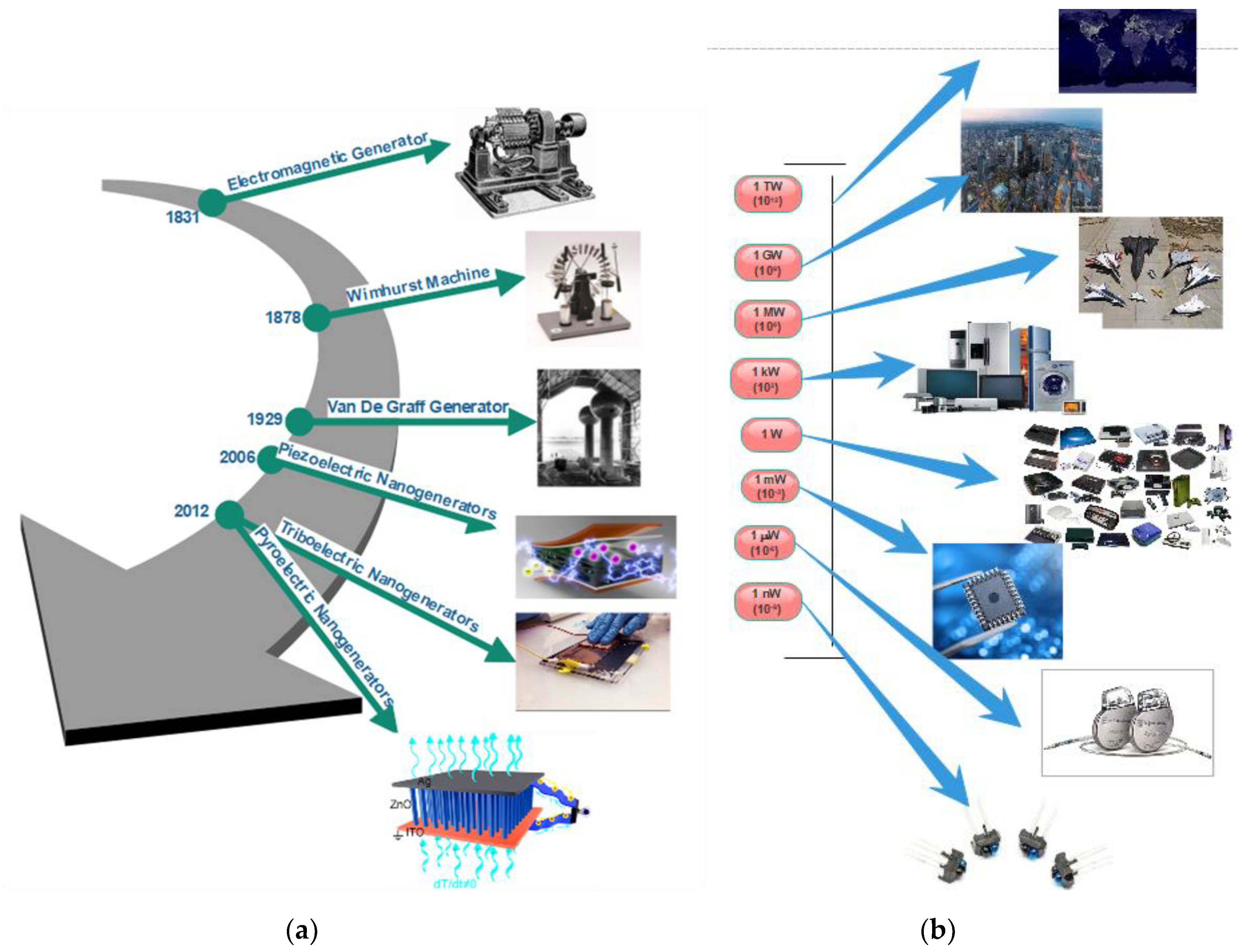
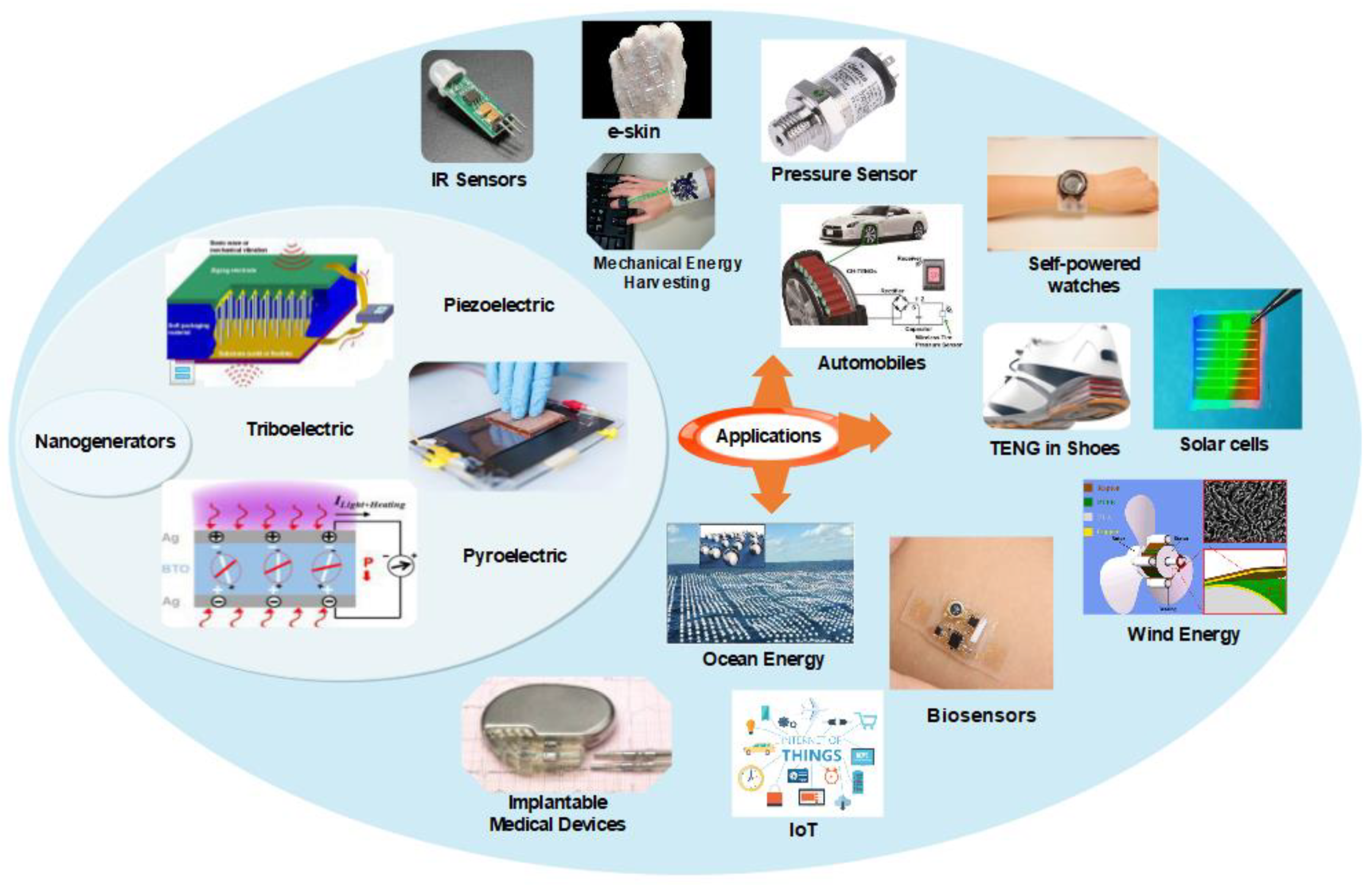
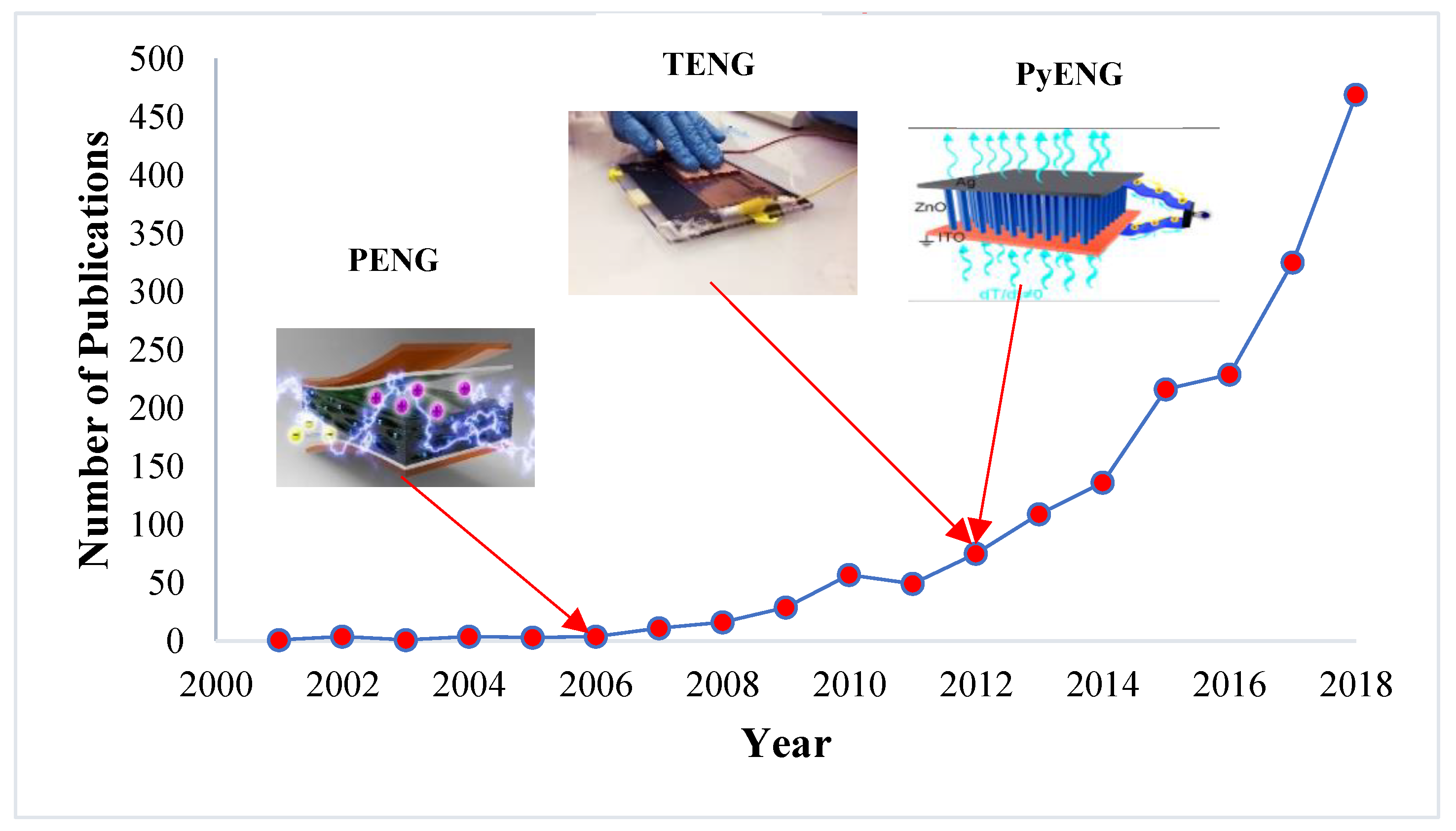
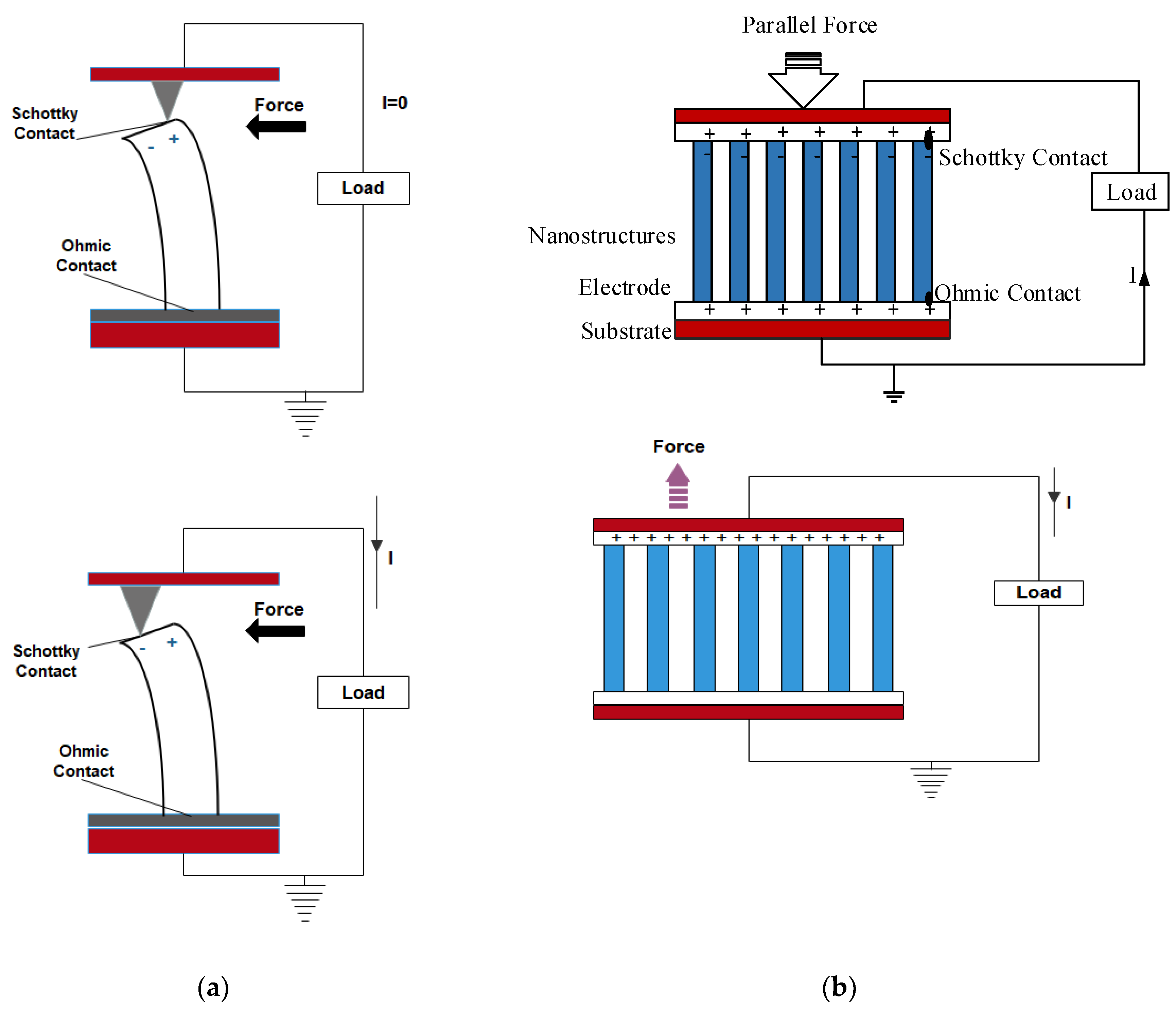
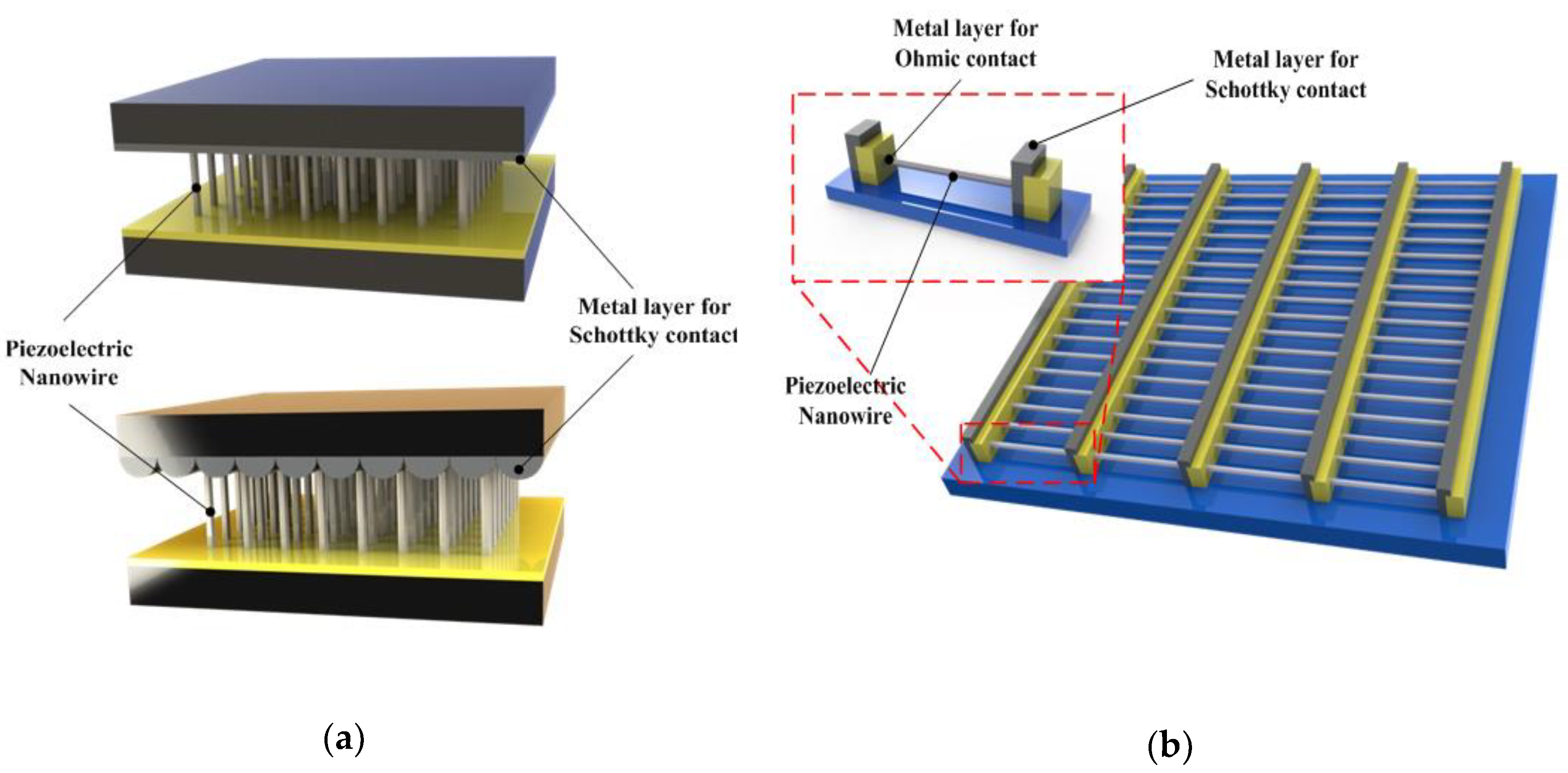
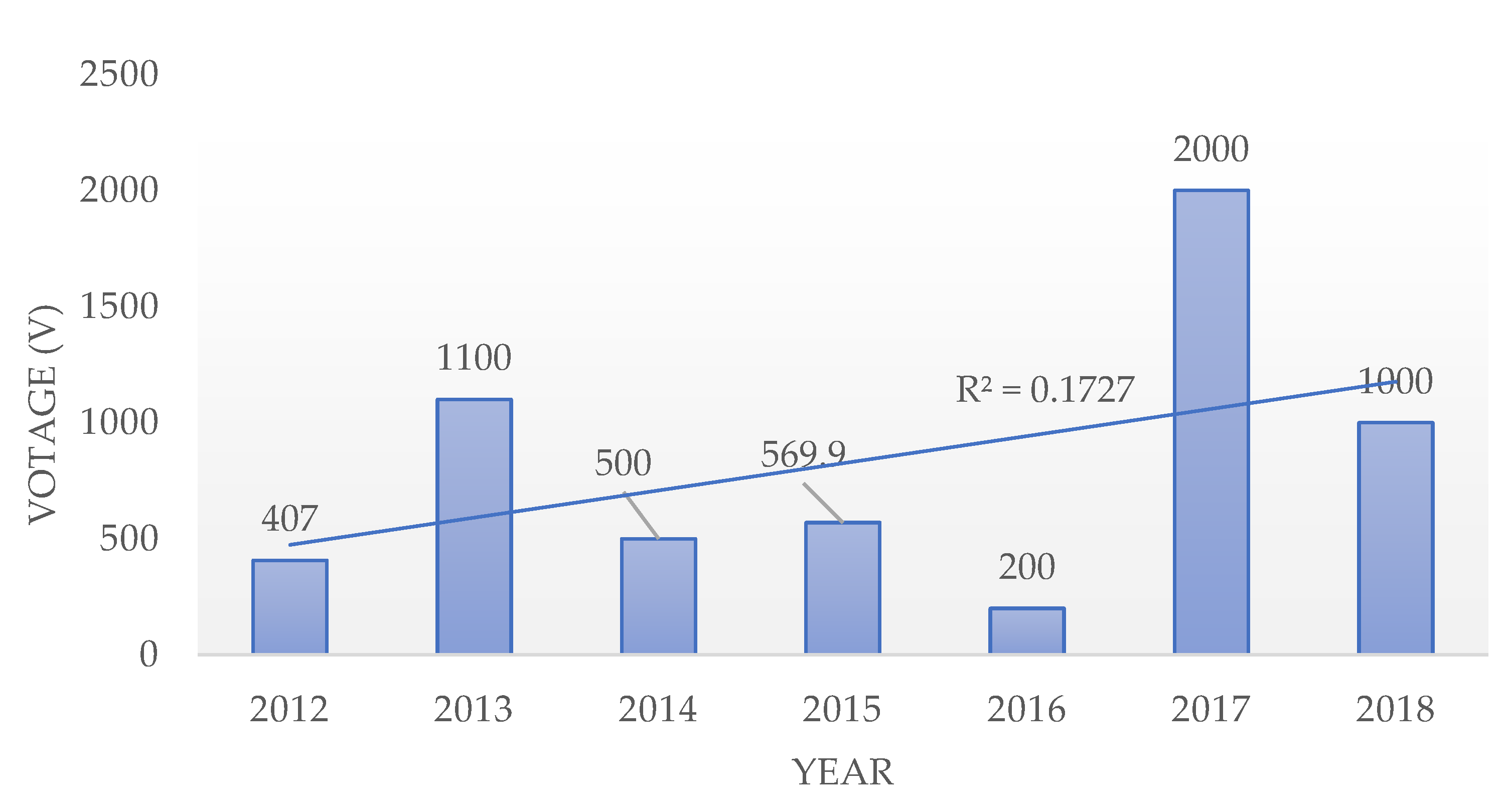
| Body Motions | Mechanical Energy | Available Electrical Energy | Electrical Energy Per Movement |
|---|---|---|---|
| Blood Flow | 0.93 W | 0.16 W | 0.16 J |
| Exhalation | 1 W | 0.17 W | 1.02 J |
| Inhalation | 0.83 W | 0.14 W | 0.84 J |
| Upper Limbs | 3 W | 0.51 W | 2.25 J |
| Walking | 67 W | 11.39 W | 18.90 J |
| Fingers Typing | 6.9–19 mW | 1.2–3.2 mW | 226–406 mJ |
| Year | Author | Materials | Output Voltage & Short-Circuit Current | Frequency/Strain | Power Output | Output Area Power Density | Output Volume Power Density |
|---|---|---|---|---|---|---|---|
| 2006 | Wang et al. [8] | ZnO nanowires | ~6–9 mV | ~10 MHz | 0.5 pW/NW | ~1 nW/cm2 | - |
| 2007 | Wang et al. [23] | ZnO nanowires | −0.7 mV, 0.15 nA | 41 kHz | ~0.1 pW/NW | 10 µW/cm2 | 1–4 W/cm3 |
| 2008 | Qin et al. [24] | ZnO nanowires | 1–3 mV, 4 nA | <10 Hz | - | 20–80 mW/cm2 | - |
| 2009 | Yang et al. [26] | ZnO nanowires/Kapton film | ~50 mV, 400–750 pA. | 22 cycles per minute | - | - | |
| 2010 | Zhu et al. [27] | ZnO nanowires/PDMS film/Au film | 2.03 V, 107 nA, 200 pA (single nanowire) | 0.33 Hz, 0.1% strain, and strain rate of 5% s−1. | - | 22 µW/cm2 (single layer)0.44 mW/cm2 (20 NW layers) | ~11 mW/cm3 (single layer)~1.1 W/cm3 (20 NW layers) |
| 2010 | Xu et al. [29] | ZnO nanowires | 1.26 V, 28.8 nA | 0.19% strain | - | - | 2.7 mW/cm3 |
| 2010 | Huang et al. [30] | InN nanowires | 1 V | - | - | - | - |
| 2010 | Chen et al. [31] | PZT nanofibres/platinum wires/PDMS | 1.63 V | 39.8 Hz | 0.03 µW | ||
| 2011 | Cha et al. [32] | PVDF nanowires | 2.6 V, 0.6 µA | - | - | - | 0.17 mW/cm3 |
| 2012 | Zhu et al. [18] | ZnO nanowires/PMMA layer/ITO layer/Al | 58 V, 134 µA | - | - | - | 0.78 W/cm3 |
| 2012 | Hu et al. [35] | ZnO nanowires/PMMA/Cr, Au electrodes | 20 V, 6 µA | 0.12% strain at strain rate of 3.56% s−1. | - | - | 0.2 W/cm3 |
| 2016 | Ghosh and Mandal [44] | Transparent fish scale | 4 V, 1.5 µA | 0.17 MPa | - | 1.14 µW/cm2 | - |
| 2016 | Lu et al. [43] | ZnO/PMMA/FTO, gold electrodes | 2 V | - | - | - | - |
| 2017 | Cho et al. [42] | Li-doped CuO2/ZnO | - | - | ~52.5 µW | - | - |
| 2017 | Haibo et al. [45] | NKN nanorods | 35 V, 5 µA | 2.13% strain at strain rate of 3.7% s−1. | 16.5 µW | - | - |
| 2017 | Chen et al. [46] | P(VDF-TrFE)/BaTiO3 | 13.2 V | - | - | - | - |
| 2017 | Ku et al. [56] | InN | 825 µV | 5 Hz | - | 2.9 nW/cm2 | - |
| 2017 | Kang et al. [53] | GaN/PET | 4.2 V, 150 nA | Shear stress ~182 mN | - | - | - |
| 2018 | Dudem et al. [47] | BaTiO3/PVDF, Ag/BTO | 14 V, 0.96 µA | 3 N, 5 Hz | - | ~98.6 µW/cm2 | - |
| 2018 | Jenkins et al. [49] | FF peptide nanowire | −0.6 V, 7 nA | 10 nN force applied | 0.1 nW | - | - |
| 2018 | Johar et al. [54] | p-n NiO/GaN/PDMS/ITO/PET | 30 V, 1.43 µA | 20 Hz | - | - | - |
| 2018 | Johar et al. [55] | GaN/Ni/PDMS | 15 V, 85 nA | - | - | - | - |
| 2018 | Lee et al. [57] | PZT-NH2 nanoparticels | 65 V, 1.6 µA | - | 26 µW | - | - |
| 2019 | Filippin et al. [51] | ZnO nanowires | 170 mV | - | - | - | - |
| 2019 | Maria et al. [58] | Bi4Ti3O12, BiTO NPs/PDMS | 12.5 V, 100 nA | - | - | 562 µW/cm2 | - |
| Modes of Operation | Mechanism | Application |
|---|---|---|
1. Vertical-contact separation mode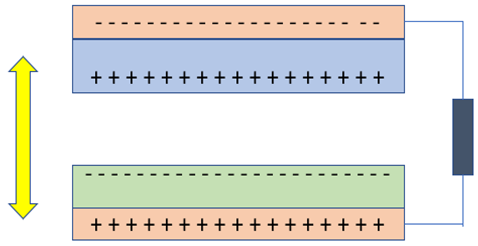 | The first invented operation mode in TENGs. The external force is applied vertically on the triboelectric materials. The charges are formed on the surface of the materials, and as they are separated by a distance, an electric potential difference is established between the two electrodes attached to the triboelectric materials. The reciprocal motion of the materials can produce alternating current. | To harvest mechanical energy from human motions, the vibration of a machine, wind, flowing water, etc. |
2. In-plane sliding mode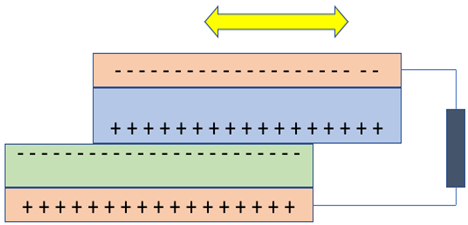 | The two triboelectric surfaces slide in the lateral direction. A lateral polarization is introduced between the materials that push the electrons from the top electron to the bottom electrode to balance the induced potential. The periodic sliding and closing can generate alternating power. The sliding can be planar, cylindrical/disc rotation. | Used to generate power from rotational motion, waves, pressing/touching, etc. |
3. Single-Electrode mode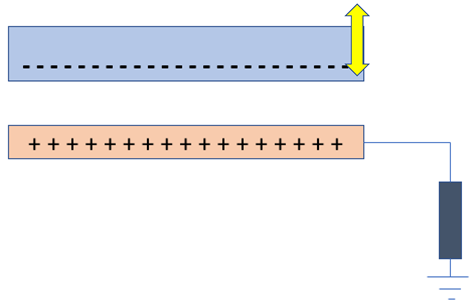 | Used to harvest energy from arbitrarily freely moving objects, unlike in the other two operation mode. It has a triboelectric surface and only one electrode and is grounded, as shown in the figure. The change of the distance between the two surfaces causes charge transfer between the electrode and the ground, thus driving electricity through an external load. | Used to harvest energy from mobile objects. Can harvest energy from turning book pages, raindrops, rotating tire, footsteps, etc. |
4. Free-standing mode | Used to harvest energy from moving objects. A pair of identical electrodes are placed below the triboelectric layer with a gap distance. An asymmetric charge distribution is generated in the media as the triboelectric layer is brought in contact and separated from the electrodes. Due to this, the electrons will flow between the electrodes to equate the potential distribution. Since there is no contact between the triboelectric layer and the electrodes, there are no chances of wear and tear. High power conversion efficiency compared to other modes of operation. | Harvests energy from automobiles, human walking, air flow, computer mouse operation, etc. |
 | Aniline-formol resin | Polyvinyl alcohol |  |
| Polyformaldehyde 1.3–1.4 | Polyester (Dacron) (PET) | ||
| Ethylcellulose | Polyisobutylene | ||
| Polyamide 11 | Polyuretane flexible sponge | ||
| Polyamide 6-6 | Polyethene terephthalate | ||
| Melanie formol | Polyvinyl butyral | ||
| Wool, knitted | Formo-phenolic, hardened | ||
| Silk, woven | polychlorobutadiene | ||
| Polyethene glycol succinate | Butadiene-acrylonitrile copolymer Nature | ||
| Cellulose | Nature rubber | ||
| Cellulose acetate | Polyacrylonitrile | ||
| Polyethene glycol adipate | Acrylonitrile-vinyl chloride | ||
| Polydiallyl phthalate | Polybisphenol carbonate | ||
| Cellulose (regenerated) sponge | Polychloroether | ||
| Cotton, Woven | Polyvinylidene chloride (Saran) | ||
| Polyurethane elastomer | Poly(2,6-dimethyl polyphenyleneoxide) | ||
| Styrene-acrylonitrile copolymer | Polystyrene | ||
| Styrene-butadiene copolymer | Polyethylene | ||
| Wood | Polypropylene | ||
| Hard rubber | Polydiphenyl propane carbonate | ||
| Acetate, Rayon | Polyimide (Kapton) | ||
| Polymethyl methacrylate (Lucite) | Polyethylene terephtalate | ||
| Polyvinyl alcohol | Polyvinyl Chloride (PVC) | ||
| (continued) | Polytrifluorochloroethylene | ||
| Polyamide 11 | Polyisobutylene | ||
| Polyamide 6-6 | Polyuretane flexible sponge | ||
| Melanime formol | Polyethylene Terephthalate | ||
| Wool, knitted | Polyvinyl butyral | ||
| Silk, woven | Polychlorobutadiene | ||
| Aluminum | Natural rubber | ||
| paper | Polyacrilonitrile | ||
| Cotton, Woven | Acrylonitrile-vinyl chloride | ||
| Steel | Polybisphenol carbonate | ||
| Wood | Polychloroether | ||
| Hard rubber | Polyvinylidine chloride (Saran) | ||
| Nickel, copper | Polystyrene | ||
| Sulfur | Polyethylene | ||
| Brass, silver | Polypropylene | ||
| Acetate, Rayon | Polyimide (Kapton) | ||
| Polymethyl methacrylate (Lucite) | Polyvinyl Chloride (PVC)Polyvinyl | ||
| Polyvinyl alcohol | Polydimethylsiloxane (PDMS) | ||
| (continued) | Polytetrafluoroethylene (Teflon) |
| Year | Authors | Tribo-Layer Used in TENG | The Electrode Used in TENG | Open-Circuit Voltage (VOC) (V) | Short-Circuit Current (ISC) (µA) | Current Density | Surface Power Density | Power Density and Power | Load Resistance (Ω) | Applications |
|---|---|---|---|---|---|---|---|---|---|---|
| 2012 | Fan et al. [88] | PET/Kapton | Gold(Au)–Palladium(Pd) alloy film | 3.3 | 0.6 | - | - | ~10.4 mW/m3 | - | Self-powered systems |
| 2012 | Zhu et al. [98] | PMMA/Kapton nanowires | Aluminum | 110 | 6 | - | - | 31.2 mW/m3 | - | Small portable electronics |
| 2012 | Wang et al. [186] | PDMS/Kapton/SiO2 | Aluminum | 230 | 94 | - | - | 128 mW/m3 | 50 MΩ | Portable electronics |
| 2012 | Zhong et al. [187] | PTFE/PET | Cu/Ag | 407 | ~33 | - | - | ~4.125 mW | - | Mobile electronics |
| 2013 | Zhu et al. [188] | Acrylic/PTFE | Aluminum/Copper | 615 | 0.44 | 0.18 A/m2 | - | - | - | Mechanical energy harvesting |
| 2013 | Hu et al. [101] | Acrylic sheet/Kapton film | Al/Cu | 110 | 15 | - | 2.76 W/m2 | - | 6 MΩ | Wave energy harvesting |
| 2013 | Chen et al. [102] | PTFE/Acrylic | Al/Cu | 287.4 | 76.8 | - | 726.1 mW/m2 | - | - | Self-powered vibration sensors |
| 2013 | Yang et al. [112] | PTFE/PET | Al/Cu | 428 | 1.395 | - | 30.75 W/m2 | - | 2 MΩ | Harvest walking energy |
| 2013 | Cheng et al. [103] | PMMA/PDMS/SiO2 nanoparticles | Au film | 285 | 0.53 | 1325 A/m2 | 3.6 × 105 W/m2 | 142 W | 500 MΩ | High-pulsed power source |
| PMMA/PDMS/SiO2 nanoparticles | Au film | 115 | 5.2 | 104 A/m2 | 1.4 × 104 W/m2 | - | 22 MΩ | Self-powered systems | ||
| 2013 | Hou et al. [142] | PET/PDMS | Indium tin oxide (ITO)/Cu | 220 | 40 | 0.8 µA/m2 | - | - | 103–108 Ω | Harvesting walking energy for sensors |
| 2013 | Yang et al. [189] | PTFE | Al | 1100 | - | 6 mA/m2 | 350 mW/m2 | - | 100 MΩ | Self-powered sensors |
| 2014 | Zhu et al. [115] | PTFE | Metal gratings | 0–500 | - | - | 500 W/m2 | 15 × 106 W/m3, 3 W(average power) | - | Self-powered electronics |
| 2014 | Lin et al. [105] | PTFE | PMMA/Cu | 9.3 | 17 | - | 200 W/m2 | - | 5 MΩ | Water drop energy |
| 2014 | Liang et al. [190] | PTFE | ITO | 10 | - | - | 11.56 mW/m2 | - | 0.5 MΩ | Energy from water drops |
| 2014 | Zheng et al. [180] | PTFE | ITO/PET | 30 | - | 4.2 mA/m2 | - | - | - | Solar PV |
| 2014 | Yang et al. [135] | Acrylic/polyolefin | Al | −1070 | - | 10 mA/m2 | 288 mW/m2 | - | 100 MΩ | e-skin |
| 2015 | Sun et al. [191] | Ethyl cellulose/polylactic acid/Kapton | Copper wire/silver paste | 310.5 | 16.2 | - | - | - | 0–200 KΩ | Harvesting energy from biological activities |
| 2015 | Huang et al. [192] | Polyvinylidene fluoride/poly(3-hydroxybutyrate-co-3-hydroxyvalerate)/PET substrate | Aluminum | 340 | 78 | - | 2.3 W/m2 | - | 0.1–40 MΩ | Self-powered sensors |
| 2015 | Chen et al. [159] | Acrylic/PET/PTFE | Al/Cu | 569.9 | 930 | - | 2.6 W/m2 | - | 1–10 MΩ | Blue energy harvesting |
| 2015 | Zhang et al. [193] | PET | ITO | 98 | 16.3 | - | 2.76 W/m2 | - | - | Wind energy harvesting |
| 2015 | Wu et al. [194] | PET/PDMS/rice husk/PTFE | Al/Cu | 270 | 14 | 5.7 mA/m2 | 0.84 W/m2 | - | 200 MΩ | Industrial applications |
| 2015 | Wang et al. [156] | Nylon 6/6 and Kapton | Al | ~900 | 1 | - | - | 10 mW | 10 GΩ | Water wave energy harvesting |
| 2016 | Park et al. [195] | PTFE | Al/Cu nanostructures | 200 | ~10 | - | - | - | - | Self-powered sensors |
| 2016 | Chen et al. [196] | PTFE | Al | 150 | 78 | - | - | 8.58 mW | 6 MΩ | Force sensing |
| 2016 | Yong et al. [197] | Expanded polystyrene (EPS)/Polyvinyl Chloride (PVC) | Ag | 11.2 | 1.86 | - | - | - | - | Wind energy harvesting |
| 2017 | Chen et al. [107] | Printed composite resin | ionic hydrogel | 62 | - | - | - | 10.98 W/m3 | - | Wearable devices/AI/IoT |
| 2017 | Mallineni et al. [97] | Kapton/Teflon | gPLA | 2000 | - | - | - | 70 mW | - | Self-powered sensors |
| 2017 | Li et al. [168] | FEP nanowires/Au | Ag | 200 | 10 | - | - | - | - | Blue energy/wireless infrared system |
| 2018 | Feng et al. [96] | PDMS/polyamide 6/leaf powder/poly-l-lysine to modify the surface | Conductive double-sided carbon | 1000 (max) | 150 (max) | - | - | - | - | Wind energy harvesting |
| 2018 | Qian et al. [140] | Polymide/PDMS/PTFE | aluminim | 316 | - | - | - | 22.3 mW | 3 MΩ | Pressure monitoring |
| 2018 | Liu et al. [182] | PDMS | PEDOT:PSS | ~2.14 | ~0.033 | - | 17.4 W/m2 | - | - | Solar PV |
| 2018 | Dong et al. [120] | MXene | PET-ITO | ~500 to ~650 | - | - | - | 0.5–065 mW | - | wearable/flexible electronics |
| 2018 | Lei et al. [162] | PTFE | Cu | 707.01 | 75.35 | - | - | 9.559 W/m3 | - | Blue energy harvesting |
| 2018 | Pang et al. [161] | Calcium alginate | Al | 33 | 0.15 | 9.5 µW | Blue energy harvesting | |||
| 2018 | Sun et al. [134] | PDMS | Ag nanowires/PEDOT | ~100 | - | - | 3200 W/m2 | - | - | Energy skin/soft devices |
| 2019 | Luo et al. [124] | FEP/PDMS/Kapton/PET | Al | - | 37 | - | - | 1.83 mW | 2 MΩ | Flexible electronics |
| 2018 | Wang et al. [198] | Silicone/Kapton | Cu | 290 150 | 2.8 15 | - | - | 165 µW 850 µW | 20 MΩ 100 Ω | Desalination/self-powered marine rescue system |
| 2019 | Xia et al. [199] | Solid milk film/PTFE film | Conductive ink | 392 | 93 | - | 5.837 W/m2 | - | - | Flexible, wearable electronics |
| 2019 | Hao et al. [175] | PMMA/silicon (TENG/EMG hybrid) | Ag/Al | 80 V/13 V | 1.2 µA/2000 µA | - | - | TENG: 0.08 mW EMG: 179 mW | 100 MΩ 1 kΩ |
| Year | Authors | Pyroelectric Material and Electrodes | Pyroelectric Current Coefficient | Pyroelectric Voltage Coefficient | Output Voltage/Current | Current Density | Power Density/Power |
|---|---|---|---|---|---|---|---|
| 2012 | Yang et al. [206] | ZnO nanowires, Ag/ITO | ~1.2–1.5 nC/cm2 K | ~2.5–4 × 104 V/mK | - | - | ~0.05–0.08 Vm2/W |
| 2012 | Yang et al. [80] | PZT film, Cu/Ni layer | −80 nC/cm2 K | - | ~22 V | 171 nA/cm2 | |
| 2014 | Ko et al. [207] | PMN-PT | ~104–235 nC/cm2 K | - | 1.1 V, 10 nA | - | - |
| 2017 | Xue et al. [208] | PVDF the film, Al | 27 µC/m2 K | - | 42 V, 2.5 µA | - | 8.31 µW |
| 2017 | Ma et al. [209] | BaTio3, Ag | 2.1 nC/cm2 K | - | 2.2 nA | - | 60.3 nW |
| 2017 | Moalla et al. [210] | Pb(Zr0.52 Ti0.48)O3 | −470 µC/m2 K (static) 30 µC/m2 K (dynamic) | - | - | - | - |
| 2017 | Jiang et al. [211] | GaN | - | 7 × 105 V/mK | - | - | - |
| 2017 | Raouadi et al. [212] | PVDF film/vortex generator | 27.15 µC/m2 K | - | - | 0.109 µA/cm2 | 2.82 µW/cm2 |
| 2018 | Yang et al. [213] | PbTiO3 nanowires/P(VDF-TrFE) | 52.7 µC/m2 K/72.8 µC/m2 K | - | - | - | - |
© 2019 by the authors. Licensee MDPI, Basel, Switzerland. This article is an open access article distributed under the terms and conditions of the Creative Commons Attribution (CC BY) license (http://creativecommons.org/licenses/by/4.0/).
Share and Cite
Sripadmanabhan Indira, S.; Aravind Vaithilingam, C.; Oruganti, K.S.P.; Mohd, F.; Rahman, S. Nanogenerators as a Sustainable Power Source: State of Art, Applications, and Challenges. Nanomaterials 2019, 9, 773. https://doi.org/10.3390/nano9050773
Sripadmanabhan Indira S, Aravind Vaithilingam C, Oruganti KSP, Mohd F, Rahman S. Nanogenerators as a Sustainable Power Source: State of Art, Applications, and Challenges. Nanomaterials. 2019; 9(5):773. https://doi.org/10.3390/nano9050773
Chicago/Turabian StyleSripadmanabhan Indira, Sridhar, Chockalingam Aravind Vaithilingam, Kameswara Satya Prakash Oruganti, Faizal Mohd, and Saidur Rahman. 2019. "Nanogenerators as a Sustainable Power Source: State of Art, Applications, and Challenges" Nanomaterials 9, no. 5: 773. https://doi.org/10.3390/nano9050773
APA StyleSripadmanabhan Indira, S., Aravind Vaithilingam, C., Oruganti, K. S. P., Mohd, F., & Rahman, S. (2019). Nanogenerators as a Sustainable Power Source: State of Art, Applications, and Challenges. Nanomaterials, 9(5), 773. https://doi.org/10.3390/nano9050773





